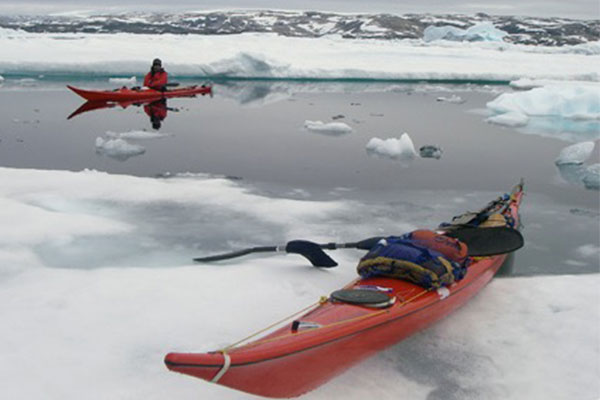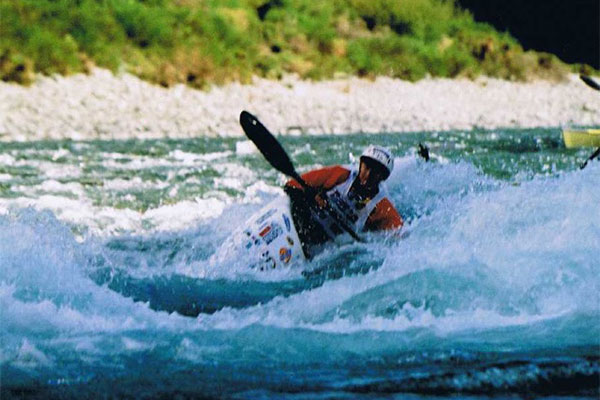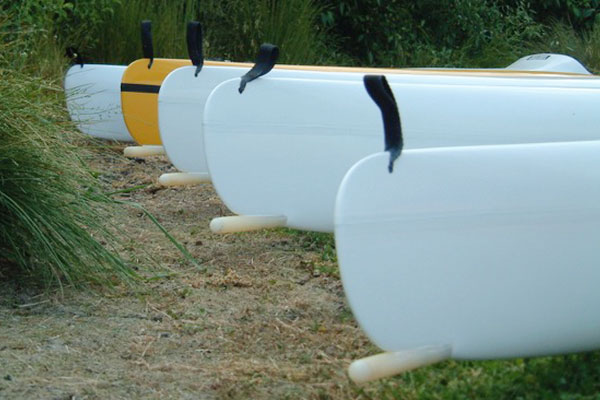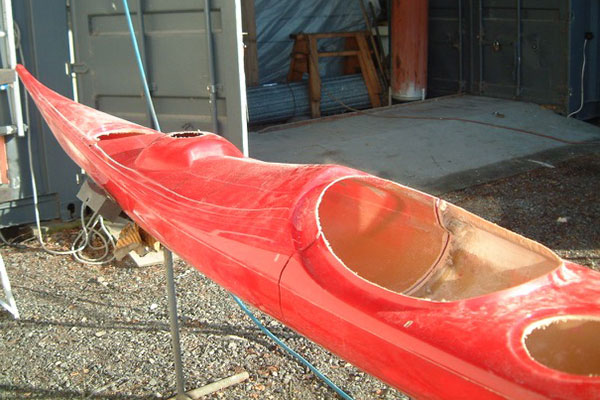Voyager Expedition Sea Kayak
Date: May 22nd, 2017
Imagine this – Eighteen years after taking delivery.
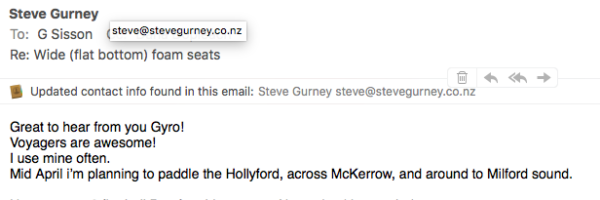
Part of an email received from Steve Gurney – March 27th 2018
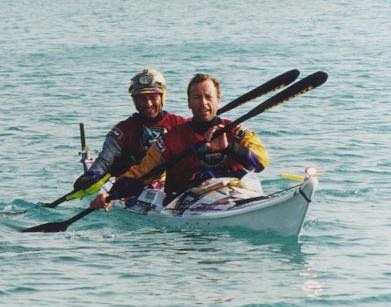
Jeff Mitchell in the bow. Team Seagate wins! This from the days before the Southern Traverse – lost it way.
The Voyager is a fully blown sea kayak that comes with Humps©, Sidetanks©, Real hatches, decklines and a fully retracting rudder.

Utopia for two – but – Never ever mention this to Jane Martin
In addition to the fore/aft compartments in the Voyager Multisport version, the Voyager Sea Kayak comes with a small central hold and additional compartment behind the stern cockpit. (Note:- the interim photos above do not yet show these extra two hatches).

The “Greenlander” bow provides dynamic lift when the boat strikes a wave, thus providing a lifting action to keep the bow paddler drier and paddling harder. The hull design of the Voyager carries its wide load-carrying water plane over a greater area to enhance the response to changing water surface conditions. The Humps© allow the stern paddler to keep the feet in the normal straight-up orientation allowing a much stronger paddling position. The deckline tubes and Sidetanks© add strength and stiffness to the Voyager so that it rams “shudderless” through large waves.
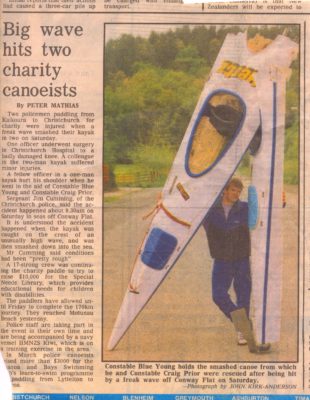
A ‘light-fast’ double from elsewhere. Serious leg injuries sustained. The reason the Voyager has Side-Tanks (girders).
The Real hatches keep the pressure tested compartments dry at all times. The Voyager is the first kayak in the world to come fitted standard with Steve Gurney’s great Bumfortible foam seats.

Utopia for two
The Voyager is a real boat made the real way. Our boats are built tough. Instead of making the Voyager super light we specify a construction that is strong enough to do the job. Why race a 26kg boat when the race rules say that the boast must weigh 50kg?????!!!
Our customers 30-35kg Voyagers clearly worked just fine.

Jeff Mitchell in the bow. Teak Seagate wins!
Lets have the whole team
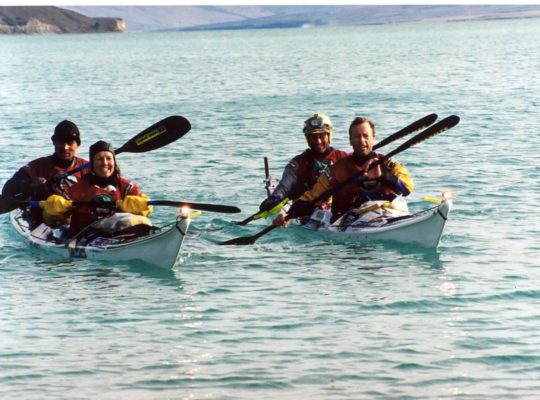
Team Seagate winning the Southern Traverse in the days when it had not degraded into a kayak sprint
Some unsolicitored quotes:
Jeff Mitchell – “You have another good boat there! Quick on the flat water of Lake Coleridge which we were first across after the group started together on the second day. I was in the front of one, really nice to paddle. It felt like a racing boat as it was going so cleanly through the water. Stable, quick, appears really solid, and looks damn good. It is on my shopping list for later!”
Nathan Fa’avae – “Left the JKK boats in our dust”
Meanwhile Conrad Edwards (many time winner of the Portage Race) has purchased two Voyagers. One of Conrad’s Voyagers is split.
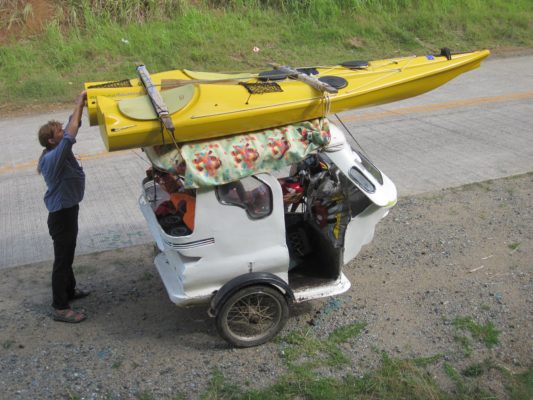
This Voyager has seen more of the world than I have. Palawan 2012. And I also know for sure – the entire coastline of Turkey.

Detail of the Voyager split. Note the alignment spigots. ‘O’ rings seal the bolts
Steve Gurney – “Three Voyagers went cruising to Ripapa Island two nights ago. A stiff Easterly blew up for our return, so I got out the kite. YEEEEEEEHHHHHHHAAAAR! Ian and I were launching off waves, skipping past the others having the time of our lives! What a blast! Nice boats thanks Giro (my nickname), they handle the rough and tumble really well. Lisa and I took it fishing to Motunau Beach. We caught 9 Blue Cod. Lisa and I are just about to out for an hour or so now. That makes it 5 days in a row in the Voyager.”
Jim Davidson – “We love our boats”
Ian Adamson – “The boats went really well, and we did our best to destroy them! John managed to pile into a cliff doing 15 knots on the Rakaia, and only succeeded in making a 10cm crack in the nose! Mike and I went over a 1 metre drop and seesawed for a minute or so over the lip before plunging down into the river. We didn’t notice the boat flex even a mm”
Relay none of this to Jane Martin. Voyagers are useless. She told me so!
Posted in: Sea Kayaks
Voyager Adventure Racing Kayak
Date: May 22nd, 2017
Imagine this eighteen years after taking delivery.

Part of an email received from Steve Gurney – March 27th 2018

Jeff Mitchell in the bow. Teak Seagate wins! This from the days before the Southern Traverse – lost it way.
The Voyager is a fully blown sea kayak that comes with Humps©, Sidetanks©, Real hatches, Decklines and a fully retracting rudder. The hull complies with the Southern Traverse Race 550mm waterline beam rule. – but – Never ever mention this to Jane Martin
The “Greenlander” bow provides dynamic lift when the boat strikes a wave, thus providing a lifting action to keep the bow paddler drier and paddling harder. The hull design of the Voyager carries its wide load-carrying water plane over a greater area to enhance the response to changing water surface conditions. The Humps© allow the stern paddler to keep the feet in the normal straight-up orientation allowing a much stronger paddling position. The deckline tubes and Sidetanks© add strength and stiffness to the Voyager so that it rams “shudderless” through large waves.

A ‘light-fast’ double from elsewhere. Serious leg injuries sustained. The reason the Voyager has Side-Tanks (girders).
The Real hatches keep the pressure tested compartments dry at all times. The Voyager is the first kayak in the world to come fitted standard with Steve Gurney’s great Bumfortible foam seats.
The Voyager is a real boat made the real way. Our boats are built tough. Instead of making the Voyager super light we specify a construction that is strong enough to do the job. Why race a 26kg boat when the race rules say that the boats must weigh 50kg?????!!!
Glass or Kevlar construction? You choose. The Kevlar Voyager option is not specified to be much lighter in weight than the Glass. The Kevlar option is aimed at super strength that most people will never use. The Glass option is specified to be strong enough to do the job. Because the Kevlar lay-up is using the Kevlar for added strength (rather than lighter weight) – it is bombproof strong! At the end of the day it is your choice. The year 2000 Southern Traverse winners the Propellor Heads had a bet both ways. Nathan’s boat is Glass and Steve’s boat is Kevlar. During their race there was no reported difference it boat performance. But then – they have the experience to avoid tree (or rock) wraps in midstream. If you do wrap (fold) a Voyager – chances are a Kevlar one may unfold, tape up and finish the race. A wrapped Glass Voyager will come home in two pieces. Your choice!
Nathan recently attempted a big surf ‘breakout’ off a small Banks Peninsular beach that resulted in a backwards loop onto the rocks at one end of the beach. The damage sustained to his Glass Voyager – massive gelcoat scratches and a bent rudder blade. Zero structural repairs needed. The Glass Voyagers are proven tough.

Team Seagate winning the Southern Traverse in the days when it had not degraded into a kayak sprint
Only eleven teams (56 started) finished the 2000 Discovery Southern Traverse Race. Our Voyager customers placed 1st, 3rd and 7th. The feedback from these happy customers is very strong and positive. “We like our boats” is one comment that really says it all. Subsequent feedback from our customers indicates that they are getting regular recreational pleasure from their Voyagers. Steve Gurney is at present writing a column on his findings on the sea…………..It’s all good!
Some unsolicitored quotes:-
Jeff Mitchell – “You have another good boat there! Quick on the flat water of Lake Coleridge which we were first across after the group started together on the second day. I was in the front of one, really nice to paddle. It felt like a racing boat as it was going so cleanly through the water. Stable, quick, appears really solid, and looks damn good. It is on my shopping list for later!”
Nathan Fa’avae – “Left the JKK boats in our dust”
Steve Gurney – “Three Voyagers went cruising to Ripapa Island two nights ago. A stiff Easterly blew up for our return, so I got out the kite. YEEEEEEEHHHHHHHAAAAR! Ian and I were launching off waves, skipping past the others having the time of our lives! What a blast! Nice boats thanks Giro (my nickname), they handle the rough and tumble really well. Lisa and I took it fishing to Motunau Beach. We caught 9 Blue Cod. Lisa and I are just about to out for an hour or so now. That makes it 5 days in a row in the Voyager.”
Jim Davidson – “We love our boats”
Ian Adamson – “The boats went really well, and we did our best to destroy them! John managed to pile into a cliff doing 15 knots on the Rakaia, and only succeeded in making a 10cm crack in the nose! Mike and I went over a 1 metre drop and seesawed for a minute or so over the lip before plunging down into the river. We didn’t notice the boat flex even a mm”
Posted in: Multisport Racing Kayaks
Tillerbar Footrest
Date: May 21st, 2017
Sidebars SK125 (shown in photo) and fastenings are not included. If required – order sidebars as a separate spare part.
Full description of this footrest advantages / disadvantages are listed on previous page.
Specify the Sisson Kayak model so that we send you the correct length of bar.
Posted in: Foot Rests, Kayak Spares
Split Sea Kayaks
Date: May 21st, 2017
Three piece splitting capabilities for your new Sisson Kayaks sea kayak.
Posted in: Kayak Upgrades
Southern Light EX Sea Kayak
Date: May 21st, 2017
In the beginning…
Over a decade has passed since the 1989 release of the Southern Light double sea kayak. The 1989 version broke new ground in several areas of design and fit-out. Some of these are now touted as ‘Industry standard features’.
Back in 1989 we developed the original boat in total isolation. No other New Zealand kayak manufacturer had built a kayak of this type. Our development motivation was simple – we wanted one of these boats for our own use. Our paddling needs were in hindsight the same as many future customers.
Now – to the 1996 EX version
It is shorter and more compact
The seats are even larger
The centre hold is even bigger
The rudder is mounted even stronger
The response to rudder control works even better
The hull is even softer riding into a head sea
The bow paddler gets an even dryer ride
The Kevlar construction option makes for an even lighter easier handled boat
The standard 4 lifting handles and two toggles makes onshore handling even easier
The ‘Industry standard, footrest system is even more comfortable and easy to adjust
The above list was compiled from customer feedback. The above list was also our mission statement.
Our customers say we got it right!
The Southern Light EX is a whole lot more boat than other industry imitators. Who knows – it may even be a more affordable option!
Over many years the 1989 Southern Light has proven to be a very safe boat. There has not been even one reported instance of the Southern Light ‘tipping over’ on open water. There has been no reported instance of the Southern Light ‘blowing over’ on open water.
In all respects the Southern Light EX is an even better boat.
The concept as envisaged has proven to be a fact!
Paddlers of limited kayaking ability with uneven strength have completed many trips in total safety. The cargo hold concentrates the mass of both paddlers equipment where any ships captain worth his salt would put it… in the MIDDLE!
It you are confused about the comparative safety of different double sea kayaks, do this. Demand an on-water demonstration of the kayaks you most fancy. Load the cargo spaces with weight comparable to your camping/personal gear, roll the boat over on the water and execute a self rescue. In the Southern Light it’s as easy as rolling it over upright and climbing in and paddling. That’s right! The small amount of water in the cockpits is water ballast. Other doubles fair worse!!!! Some may leave you in deep trouble.
The manufacturers of some of the above suspect kayaks have recently adopted our idea of the centre hold. BEWARE! The Southern Light is the only double sea kayak designed from the outset as a centre hold boat. Some others reportedly “blow over” in strong cross winds.
The Southern Light was always designed to have a centre hold.
It’s proven!!
Posted in: Sea Kayaks
Snap Shackle (pair)
Date: May 21st, 2017
For attaching rudder cords to Quadrants.
Posted in: Kayak Spares
Skevolution Multisport Racing Kayak
Date: May 21st, 2017
Take one Evolution Classic hull-deck unit and cut away the cockpit area. Add internal bracing and bond the custom designed surfski deck panel to the kayak deck. The resultant ski is no longer a kayak.
It is an Evolution Ski! A Skevolution!
Click to enlarge these photos
LEFT PHOTO:- The 300mm (12″) rule shown across the seat is actually 335mm (13¼”) long overall because of the hanger hole extention. The ruler is in contact with the hull at each end. The roll of tape is placed to give some perspective of the seat depth below the widest point. The seat pan is 30mm above the hull keel. Note the steerer cord tubes that are fibreglassed underneath the deck = zero leaks.
RIGHT PHOTO:- The footwell and footrest area allows for a wide range of leg lengths. Current production Skevolutions use improved OZO footrests. The footrest shown is an obsolete brand. The current OZO pedals off easy footrest and rudder cord adjustment.
The internal structure consists of the same polystyrene foam blocks as used in the Evolution Classic. These are permanently held in position with numerous closed-cell-foam blocks. The sit-on-top pod unit is also bonded to the hull at the sides of the seat as well as the bottom of the footwell.
In all respects the Skevolution is the same as the Evolution (Speights Coast to Coast Race record-holding kayak) Classic except the paddler sits on top rather than inside the cockpit.
The wave deflector in front of the cockpit can be trimmed by the owner to suit local conditions. It is recommended that the owner should glue closed-cell-foam sheet into the seat and cockpit floor area to make a custom fit. Surplus volume in front of the footrest may also be filled with closed-cell-foam.
A drain plug is fitted to allow the air pressure to be neutral to changing outside air pressure. Always remove this plug when the Skevolution is not in use.
Posted in: Multisport Racing Kayaks
Rudder Quadrant Mounting Tube
Date: May 21st, 2017
Fits all multisport kayaks. Compatible with SK105 and SK103
Alloy tube threaded 12mm internal. Outer surface ready to bond into kayak stern
Posted in: Kayak Spares, Ruddar Quadrants
Rudder Quadrant Bolt and Lock Nut
Date: May 21st, 2017
Sisson Spare – Rudder Quadrant Bolt and Lock Nut
Fits all Multisport kayak models since 1997 – compatible with SK103 and SK106
12mm 316 Stainless bolt with machined head to reduce weight. Comes with 316 Stainless lock nut.
Posted in: Kayak Spares, Ruddar Quadrants
Rudder Quadrant (Pre 1996 Multisport)
Date: May 21st, 2017
Sisson Spare – – Pre 1996 Multisport models
1/2 inch bore in the plastic bush (bolt hole).
Identification check – the bush (bolt hole) that the pivot bolt runs through is 30mm from the top surface to the bottom surface.
Comes with plastic shackles and shock cord.
Posted in: Kayak Spares, Ruddar Quadrants
Ruddar Quadrant (1997+ Multisport)
Date: May 21st, 2017
Sisson Spare – Rudder Quadrant – 1997 Multisport models onwards to current models
12mm bore in plastic bush.
Identification check – the bush (bolt hole) that the pivot bolt runs through is 23mm from the top surface to the bottom surface.
Comes with plastic shackles and shock cord.
Posted in: Kayak Spares, Ruddar Quadrants
Replacement Rudder Cord, Polyester
Date: May 21st, 2017
Cords should be replaced every two years or before any major race. This 8 metre kit fits all Multisport kayaks from Sisson Kayaks.
Posted in: Cords, Kayak Spares
Polystyrene Block Patterns
Date: May 21st, 2017
Full size paper pattern for the full set of polystyrene foam blocks in your kayak. Only available for current models in production. Do-It-Yourself upgrade of these most important foam blocks made easy!
Posted in: Kayak Spares
Pepin Sea Kayak
Date: May 21st, 2017
December 2019. Production continues in Winton. Email Rikki Griffin – rikki@nautiquekayaks.co.nz – find out more.
WE HAVE COME FULL CIRCLE AND MADE THE ELIMINATOR INTO A SEA KAYAK THAT BLOWS THE SOCKS OFF OTHER BUDGET PRICED ‘SEA KAYAKS’.
When you take what is arguably one of the best sea kayak hulls, and make it into a competitive multisport racing kayak, you just happen to end up with a kayak that goes well in the sea! On land this kayak is light enough to carry your paddle in one hand and the kayak in the other – just try doing that with most similar priced ‘plastic’ sea kayaks!
- By adding bulkheads, the floodable floatation volume ends up about the same as our older (pre-1985) Nordkapps have.
- The fitting of two hatches to the decks allows for the placement of camping gear inside the floatation compartments. Should a larger hatch be required for the rear compartment, the optional large hatch upgrade can easily be fitted at the time we build the kayak to your order.
- The decklines are securely fastened in the same way they are on our top line sea kayaks.
- The overdeck rudder is fitted with a deeper draft rudder blade than that generally fitted to the Eliminator. This provides better directional control when on bigger swells in open water.
- The cockpit is a full size opening and the seat is of a design that has been proven to suit a wide range of bottoms.
- The footrest is the same as that fitted to the Eliminator and the rudder is activated and controlled by pushing the tillerbar with the toes.
- Pepin owners wishing to use their boats for multisport may be apprehensive about the boats ability to ‘crunch’ over rounded river boulders in dry rivers. The concept of a river kayak with bulkheads is like aiming an axe head at the inside of the hull! Recognising this fact, we increase the longitudinal stringers from one to THREE ! This ensures that the bottom through the bulkhead-cockpit area is very self-supporting. When a rock is run over the bottom flex is minimised and the load is concentrated longitudinally rather than laterally. This results in less ‘axe head damage’.
- Refer “Astrolab” page for more details on the features of the Pepin construction and fit-out.
The Pepin will be a good multisport kayak for events on the likes of the Wanganui River where in high river flows, long swims are possible. With a paddle float, deep-water self rescues are possible.
The PEPIN is a versatile boat!
Posted in: Sea Kayaks
Pan Seat for Nucleus and Defender Models
Date: May 21st, 2017
Standard fitting pan seat for Nucleus and Defender models.
Can be made to the colour of your choice.
Posted in: Kayak Spares, Pan Seats
Pan Seat for Evolution Models
Date: May 21st, 2017
Pan Seat with standard fitting for Evolution Classic, Edge, and Extreme.
Can be made to the colour of your choice.
Posted in: Kayak Spares, Pan Seats
Pan Seat Fitting Bolt and Wingnut
Date: May 21st, 2017
Bedded onto hull with hot glue then fibreglassed to hull. Comes with Chopped strand mat. No resin included.
Secures all pan seats
Posted in: Kayak Spares, Pan Seats
OZO Footrest with Footflaps
Date: May 21st, 2017
Complete with fastenings. Angle mounting-face rail standard. (provides clearance from deck) Flat mounting rail on request. Optional-order on many of our kayak models. Standard fit – front and rear – on the Voyager Race and Expedition models.
Full description of this footrest advantages / disadvantages are listed on previous page.
Posted in: Foot Rests, Kayak Spares
OZO Footrest
Date: May 21st, 2017
Flat mounting face rail standard. Angle mounting rail on request.
For front of Southern Light, Voyager or white-water kayaks
Complete with fastenings.
Posted in: Foot Rests, Kayak Spares
Nucleus 80 Racing Kayak
Date: May 21st, 2017
December 2019. Production continues in Winton. Email Rikki Griffin – rikki@nautiquekayaks.co.nz – find out more.
An Evolution styled boat that has just the right volume for most paddlers around 80 kg.
Relaxed Esprit owners will find the Nucleus 80 much faster at all levels of effort.
The hull of the Nucleus 80 is derived from a carefully scaled down Evolution Classic. Early on in the planning stages it was decided to widen the hull waterplane adjacent to the cockpit area sufficiently to provide exceptional stability for the paddler making the transition to narrower boats. For it’s waterline beam, the Nucleus 80 is even more stable than the Nucleus 100. This is due to the flared hull side design which widens the waterplane considerably as the boat is leaned.
New Zealand Multisport Magazine rounded off their Nucleus 80 test by saying “Fast boat for mid-level folks of around 80kg. Ideal step up from the Esprit or Centrix”
The waterline length of the Nucleus 80 is optimised to minimise the effects of ‘wetted area’ drag. Experience has shown that multisport kayaks paddled aerobically (endurance intensity) are most affected by water drag caused by wetted area. Wave making drag is more a factor with boats that are sprinted anaerobically. In order to minimise the ‘wetted area’ of a boat that has been made wider, the length is best made shorter. Recent speed testing reinforces that the Nucleus hull is actually fast at low power inputs.
The deck styling of the Nucleus 80 is absolutely scaled off the record setting Evolution Classic. The whole concept is to maximise water shedding after wave penetration whilst presenting the lowest possible profile to wind grab.
The Nucleus 80 cockpit coaming is the same as the Evolution.
Posted in: Multisport Racing Kayaks
Nucleus 60 Racing Kayak
Date: May 21st, 2017
December 2019. Production continues in Winton. Email Rikki Griffin – rikki@nautiquekayaks.co.nz – find out more.
The Nucleus 60 is optimised for light paddlers. However heavier paddlers up to 100kg who like a ‘tight’ boat are taking the Nucleus 60 up to Evolution Classic type speeds in actual races.
This is the first of a ‘new generation’ of go-fast boats. The normal waterplane is narrow and fast. The ’20 degree-list’ waterplane is wide and stable! This is not a contradiction – it is just sensible design based on years of experience.
Steve Gurney reports similar moderate water performance over timed training courses as he does in his Evolution Classic. This performance was also observed by New Zealand Multisport Magazine when they quoted “– then turning against the waves at the river mouth it not only turned quickly, but had secondary stability far superior to the Evolution (Classic). The biggest surprise though was coming back up the river when it clocked in within two seconds of the Evolution (Classic)”
The whole kayak is scaled to fit a smaller paddler. The length and beam are the same as the Nucleus 80 and 100. In fact the deck on all three models, when viewed from above, shows only minor variations relating to volume.
However the side view of the Nucleus 60 reveals a very sleek profile with reduced (than the 80 &100 version) rocker, lower overall profile with reduced volume around the legs and knees. The Nucleus 60 cockpit coaming is set low so that a shorter paddler’s buoyancy aid will not interfere with the spraydeck. The spraydeck coaming is the same as the Evolutions. The famous secondary stability of the Nucleus 80 flair is even more accentuated on the Nucleus 60.
Experienced relaxed paddlers will discover the Nucleus 60 to be very stable in all conditions.
A very satisfied customer says. “I sold my Opus and raced against my Opus paddling friends who usually have 5 minutes in the hour advantage over me. Paddling my brand new Nucleus 60, I was right there with them in the race”.
Karen Hopkinson, another satisfied customer says “I managed 10th overall – first woman to break into the top 10 !!!” Karen won the woman’s section of the (Victoria Australia) 2000 JLL Challenge and “- paddled the Nucleus 60 on Lake Eildon & beat a fair few men in some rather…(censored for reasons unstated!)…” Well done Karen! Keep it up.
Posted in: Multisport Racing Kayaks
Nucleus 100 Racing Kayak
Date: May 21st, 2017
December 2019. Production continues in Winton. Email Rikki Griffin – rikki@nautiquekayaks.co.nz – find out more.
The hull of the Nucleus is derived from a carefully scaled down Evolution Classic. Early on in the planning stages it was decided to widen the hull waterplane adjacent to the cockpit area sufficiently to provide exceptional stability for the paddler making the transition to narrower boats. It was also planned to allow the resulting interior space to allow really Front-Row-Forward-Rugby-Player type paddlers to experience the delights of a fast boat.
The waterline length of the Nucleus 100 is optimised to minimise the effects of ‘wetted area’ drag. Experience has shown that multisport kayaks paddled aerobically (endurance intensity) are most affected by water drag caused by wetted area. Wave making drag is more a factor with boats that are sprinted anaerobically. In order to minimise the ‘wetted area’ of a boat that has been made wider, the length is best made shorter. Recent speed testing reinforces the fact that the Nucleus hull is actually very fast at low power inputs.
The deck styling of the Nucleus 100 is absolutely scaled off the record setting Evolution Classic. The whole concept is to maximise water shedding after wave penetration whilst presenting the lowest possible profile to wind grab.
The Nucleus 100 cockpit coaming has a longer and wider sizing which means that larger paddlers will easily enter and exit the cockpit.
Posted in: Multisport Racing Kayaks
Nordkapp Sea Kayak
Date: May 21st, 2017
December 2019. Nordkapp production continues in Winton. Email Rikki Griffin – rikki@nautiquekayaks.co.nz – find out more.
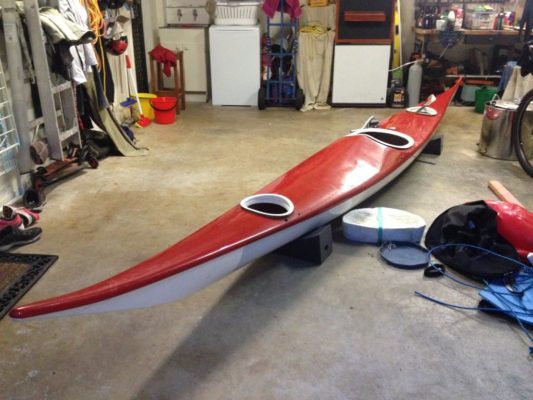
March 2018 photo of a very early 1980’s SK fibreglass Nordkapp
The Inuit tribes lived in areas of widely differing land forms and prevailing sea conditions. In order to survive, West Greenlanders had to adapt their kayak designs to cope with the roughest sea conditions. These sea conditions are similar to those experienced in Britain and New Zealand, so it is reasonable to accept that a basic design configuration which worked so well for the West Greenlanders will also work well for serious New Zealander sea kayakers.
In 1974 Frank Goodman, after close appraisal of the lines of a West Greenland kayak, modified the lines to fit a European paddler plus camping gear. Thus Frank created the Nordkapp.
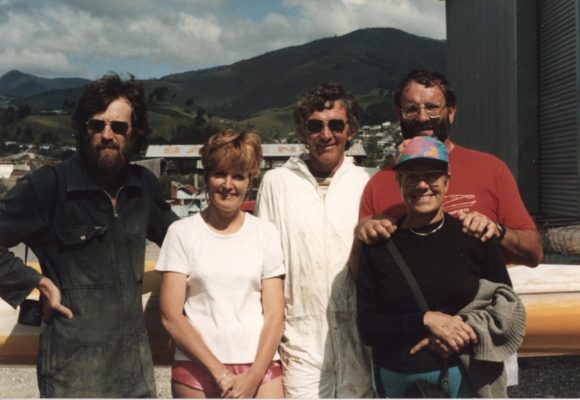
Late 80’s photo of Frank, Doreen and Paul at our factory – before Frank fell out with Paul and ourselves
Frank was an enjoyable man to have living at home. Humorous and witty. However Frank was also sensitive and easily hurt. We purchased VCP hatch covers FOB airfreight. Which meant payment-on-arrival of the documents. VCP sent a shipment by (slow-boat) seafreight – and sued us for overdue payment – before the FOB documents (and the hatch covers) had arrived. We built our own hatch covers thereafter. Never heard from Frank again.
A simple “sorry” would have been nice. We went on to wholesale our hatch covers by the thousands. Every hatch cover wholesaled was a sale missed by VCP. Sad. Never needed to happen.
In 1976 Lynda and I had mortgaged our home in order to fund a sizeable one-shot-lifetime NZ Nordkapp design royalty to Frank – associated with the Nordkapp mould purchase that we had ordered off his company – Valley Canoe Products (VCP).
The Nordkapp hull has a central load carrying section that is slightly v-shaped at the keel with soft chines and flared sides terminating at a very high gunnel line. The whole of the deck is designed to minimise the effect of the wind pushing the kayak off course, whilst the profile also clears any ‘shipped’ water quickly. The forward section of the hull is triangular in section. The lower two sides cleave the water dynamically and effectively presents a rather higher wave cleaving surface than most other kayak bow designs. The top of the triangle is a convex flat area that presents a very low side wind profile. The aft hull section is similar to the bow but runs longer and softer. At the very stem the two lower sides of the rear triangle flow gracefully into a straight running skeg that adds much to the Nordkapps’ directional stability in all water conditions.
Following our disastrous 1996 factory fire we decided to update the Nordkapp design slightly. The original Nordkapp had a very accentuated stern skeg which was designed before the days of rudders. Our latest Nordkapp is designed to incorporate a rudder. The general fit out of the Nordkapp follows the same pattern adopted 41 years ago when we constructed our first boat from the then brand new mould imported from the UK. Apart from making the cockpit foredeck higher (increased leg room) in 1986, and fitting pod seats plus rudders as standard in 1987, the boats are largely similar to the very first production. The focus is on simplicity.
Nordkapps manufactured by Sisson Kayaks have been paddled around the coastlines of New Zealand, Australia, Japan and Alaska. During all of these trips, which were sometimes conducted in heavy weather, the kayaks suffered no structural failure. Simplicity works at sea.
All Sisson Kayaks are custom built these days. You can choose the type of footrest, type of construction lay-up and all-up weight. We can advise you on what lay-up would best suit your overall needs. We built our first Kevlar kayak in 1982. It weighed 49lb all up and was used by Paul Caffyn on his Australian trip. In 1985 we went for broke and built a 30lb all up Nordkapp for Paul’s Japanese trip. It is our understanding that this kayak is still in use more than a decade later. Our Kevlar experience goes back to 1977. Our early Kevlar projects involved the creation of helicopter fertiliser spreading, spraying and deer recovery equipment. Building the very best Kevlar kayaks was easy after that.
Fibreglass construction is sometimes described by others as being inferior. They should stop to contemplate the fact that there are large numbers of 35 to 40 year old glass Sisson Nordkapps still in regular use.
Sea kayak operators are often passionate about their choice of personal boat. Large numbers of these discerning paddlers own Nordkapps for their own personal use. Why?
When the sea turns nasty, the Nordkapp just gets better.
I had heard that not long prior to his death, Frank Goodman had made some comments relating to the original 1977 HS hull being superior to the hull on the later (VCP) versions. And that the ‘new’ VCP Nordkapp would feature the original Nordkapp hull. The Sisson Kayaks Nordkapp hull!
I recently mentioned this to a customer and he replied with this link on the VCP website.
‘Effectively these repeated incremental (SHRINKAGE) changes gradually turned the Nordkapp into a caricature of itself! ‘
So sad to read about. Frank could have learned his mould making techniques from the very same place I learned my skills.
Before VCP – when Frank was still a school teacher making kayaks as a hobby – Alan Byde had written the acclaimed definitive book ‘Living Canoeing’. Everyone in kayaking bought a copy. Living Canoeing even covered basic GRP (fibreglass) canoe building. Alan followed up with another best seller – ‘Canoe Building’. This book taught me how to avoid shrinkage – and how to brace a cured mould.
Alan Byde has for many years lived in Picton NZ. I have visited him – and thanked him for the knowledge he imparted. A very humble pleasant man. In my judgement Alan would be difficult man to fall out with.
Just as happened to Lynda and I, Frank had threatened Alan with “Ruinous litigation”. Alan had simply discussed the manner in which the Inuit hunters kayak had evolved – via several other kayak designs – into the Nordkapp. Frank seemed to not be able to separate the existing kayak examples that lead to his Nordkapp IDEA – from his wonderful CREATION of the Nordkapp SHAPE. There is a huge legal gap between IDEA and SHAPE. Frank ONLY owned the Nordkapp SHAPE. Lynda and I paid Frank Goodman a large royalty to use that SHAPE in New Zealand.
Regardless – the absence of Alan’s Canoe Building book in the VCP bookrack has resulted in: – ‘Effectively these repeated incremental changes gradually turned the Nordkapp into a caricature of itself!’
Wow! Over the years I had purchased two moulds (please do not ask about the Selkie) from VCP – and had wondered about their mould-making techniques. The official VCP article in the link above confirms my concerned thinking.
Meanwhile Sisson Kayaks still produces Nordkapps from Mould #2. Mould #1 was destroyed in the 1996 fire. The properly constructed #2 mould has zero shrinkage. The hull shape of Sisson Nordkapps is the same as the original April 1977 mould. Always.
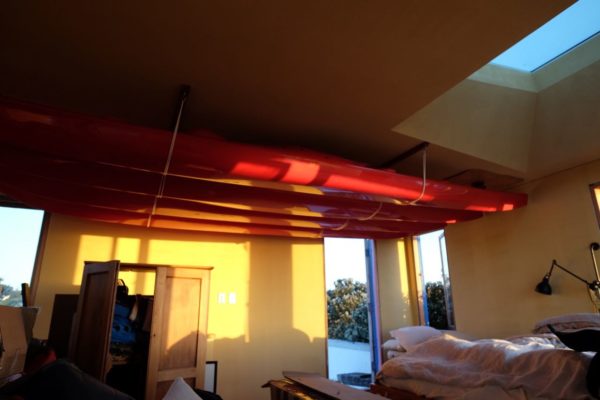
A customers bedroom ceiling decorated with spare Nordkapp hulls – just in case!
My Nordkapp customers have always known this – for so many years. Some of my Nordkapp customers have ‘stocked-up’ with Sisson Nordkapps!
Posted in: Sea Kayaks
Neoprene Cover for Southern Light Hold
Date: May 21st, 2017
Made to our specifications.
Posted in: Hatch Covers, Kayak Spares
Multisport Rudder Blade
Date: May 21st, 2017
Fits all Multisport models made since 1986
Handmade from 5251 Aluminium alloy. Comes with pivot bolt and shock cord.
Posted in: Kayak Spares
Large Stern Hatch
Date: May 21st, 2017
Fibreglass hard-shell over the top of soft neoprene cover. The coaming rim is mm long and mm wide.
Posted in: Kayak Upgrades
Kevlar Fabric
Date: May 21st, 2017
In final layer of lay-up – Pepin, Eliminator, Astrolab, Esprit, & Centrix models. Makes a stronger boat that is also slightly lighter. The advantage of lighter Kevlar in these displacement (non sprint) models is purely easier portaging and handling. No increased speed is likely
Select from the extras dropdown menu in quote form.
Posted in: Kayak Upgrades
High Performance Pan Seat for Evolution Models
Date: May 21st, 2017
HIGH PERFORMANCE pan seat for Evolution Classic, Edge, and Extreme.
Can be made to the colour of your choice.
Posted in: Kayak Spares, Pan Seats
Footpump Kit
Date: May 21st, 2017
Sorry – no longer available. Rapidflow closed down their business and I can no longer contact the owner.
Posted in: Kayak Spares
Footpump Fitted
Date: May 21st, 2017
This shows the ‘Stuffing Box’ (tube with slots)that glues to the hull bilge, outlet unit that exits the water through the deck, foot-pulse bulb that fits with Velcro to the footrest bar, and the valve block that fits to the front of the stuffing box. As pumps go – this one is very reliable and light. The foot-pulse bulb only ever contains air. We only sell these very reliable pumps as a fitted upgrade. Sorry – very difficult to photograph fitted.
Fitted at the time the kayak is built.
Posted in: Kayak Upgrades
Footflap-on-bar Footrest
Date: May 21st, 2017
Sidebars SK125 (shown in photo) and fastenings are not included. If required – order sidebars as a separate spare part.
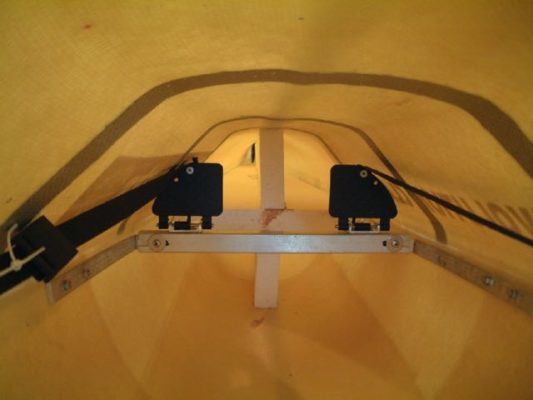
FootFlap on bar footrest with OZO pedals
Full description of this footrest advantages / disadvantages are listed on previous page.
Specify the Sisson Kayak model so that we manufacture for you, the correct length footrest bar.
Posted in: Foot Rests, Kayak Spares
Foam Seat Upgrade
Date: May 21st, 2017
Very light – very comfortable. Comes with webbing backstrap threaded through mould hole. Created, marketed and used by Steve Gurney
Posted in: Kayak Upgrades
Fibreglass Cover for Southern Light Hold
Date: May 21st, 2017
Can be made to the colour of your choice.
Posted in: Hatch Covers, Kayak Spares
Fibreglass Cover for “Large Hatch Upgrade” Hatches
Date: May 21st, 2017
Standard stock colour is BLACK. Can be made to the colour of your choice.
Posted in: Hatch Covers, Kayak Spares
Evolution Omega Racing Kayak
Date: May 21st, 2017
December 2019. Production continues in Winton. Email Rikki Griffin – rikki@nautiquekayaks.co.nz – find out more.
Imagine a (same speed) Coast to Coast paddle-time – with lower fuel-burn. Imagine that saved fuel being used-up during an amazing final cycle ride.

How does a Bulbous / Bifurcated / Bifid kayak bow function? Firstly consider that kayak paddlers have less finite power available than ships. As explained below.
- Aerobic paddling can be sustained for as long as sufficient food is consumed. The hull drag at this paddling intensity is 100% related to the ‘wetted-area-drag’ of the hull. Aerobic paddling – up the anaerobic threshold – will be faster – if a bulbous / bifurcated /bifid bow is fitted. Providing greater ‘distance-made-good’ whilst the paddler can ‘back-off’ to conserve energy reserves. Due to the on-set of wave-making drag being delayed.
- Anaerobic paddling can only be maintained for short periods of ‘sprint’ activity. The ultimate drag experienced is ‘wave-making drag’. There is NO claim that a bulbous / bifurcated / bifid bow can improve kayak sprint speed. The Inuit devised a clever stern design for that function. Forget it. The Inuit stern is NOT a valid design to use in wild rivers. And ICF Rules preclude that stern from all Sprint competition.

There are many theories. I believe Graham Eggar’s theory. The reduced ‘wash’ in ice flow ‘leads’ allowed for greater hunting stealth. The stern device facilitated an incredible sprint to the kill.
The Evolution Omega – Maybe the first production racing kayak with a bifid bow.
Over the last quarter century many other manufacturers have tried to make a better Coast to Coast race-winner kayak – than the Evolution / Classic / Edge / Extreme. Those who seem to have come closest seem to have ‘borrowed’ some of the Evolution Edge hull design.
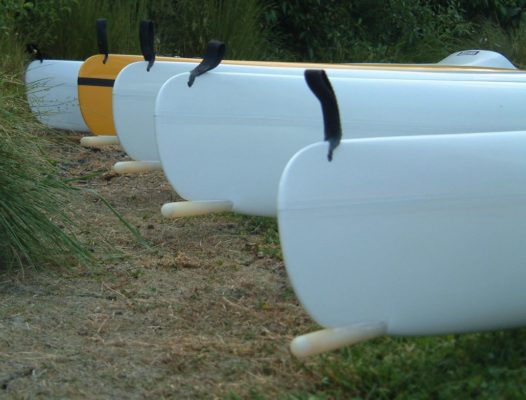
Evolution Omega production run complete with unpaid Inuit ‘Royalties’ – for stealing their bifurcated bow invention
Some manufacturers talk about their boats being “freekin”fast. In actual fact, a Coast to Coast winner will NOT be paddling at the same heart-rate as he / she would wish. They NEVER push into the ‘wave-making‘ drag-zone. They paddle firmly within the ‘wetted-area’ drag-zone. Over the years several heart rate studies have been independently conducted on Longest Day Coast to Coast competitors. Declining heart rate over the duration of the paddle – is normal.
We did some amazing tests in the Rangitata Diversion Race – using Luke Vaughan as a constant 160 hbpm (almost wave-making drag) or 130 hbpm (wetted-area drag) ‘motor’.
What is really required is a kayak that provides the greatest distance-made-good – for the lowest fuel burn. The very zone that bifid (bifurcated) bows enhance. Maybe in another 10 years ‘The Market’ will learn this fact.

Show me a modern ship without this feature. Show me a production kayak with this feature. Kayakers already know that ‘Wash-Hanging’ works. With a bulbous bow you hang-your-own-wash. Simple as that,
Ships achieve this by using technology first developed hundreds of years ago by the Inuit. I refer to ship bulbous bows. I refer to Inuit bifurcated (Bifid) kayak bows.

Sadly there are few photos – because the boats degraded before the research started
Like a ship – the Evolution kayak models are displacement vessels – when paddled at four-hour race intensity – aerobically.
This is Luke in the Evolution Edge – paddling the Rangitata Diversion Race – just 50 metres (over the fence) from the Sisson Kayaks factory.
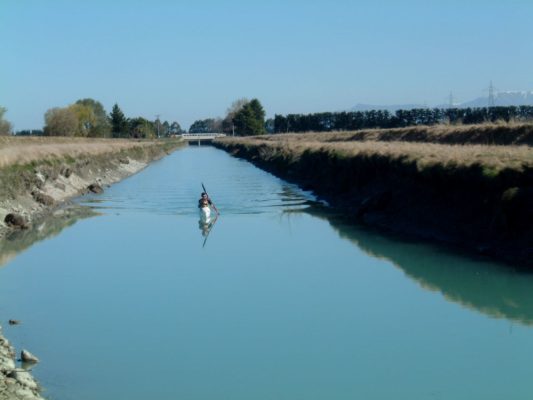
Note the rolling stern waves following the Evolution Edge.
Note the pronounced bow wave.
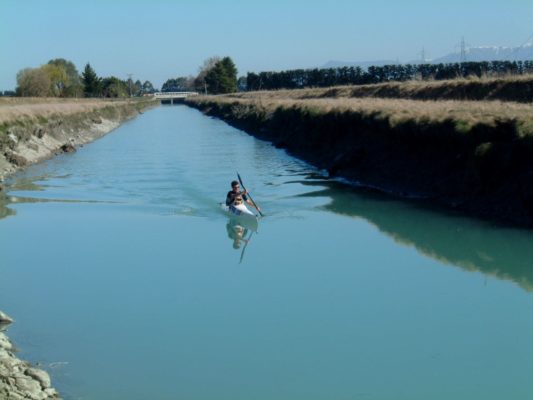
The rolling Evolution Edge wake hitting the right hand shore
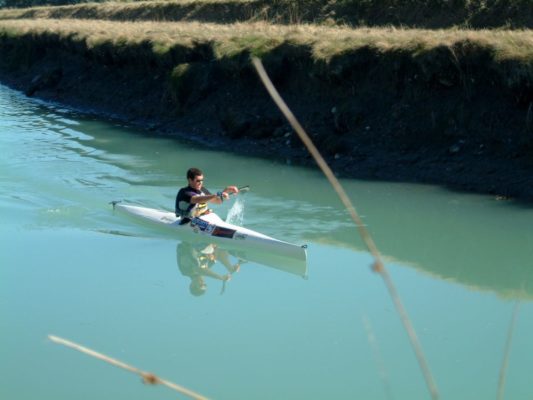
Evolution Edge wake up close
Change #1 was to adopt the Bifurcated (Bifid) Bow – a very clever invention of the ancient Inuit from the Bering Strait and East Greenland. Their craft (and amazing speed) was documented by Capt Waxell and Joseph Banks in the 1700’s.
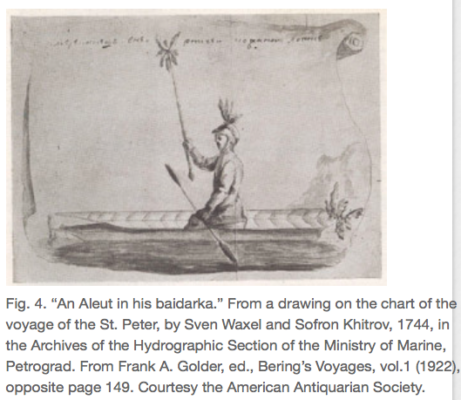
Image from the Russians first meeting with ‘The Americans’
My initial Bifurcated Bow experiments were fitted to a Woodstock Express early prototype using Ian Ferguson as the ‘motor’ – on Nelson Harbour – paddling between the ships with their bulbous bows! Do you get the picture? The kayak and photos were lost in the 1996 factory fire.
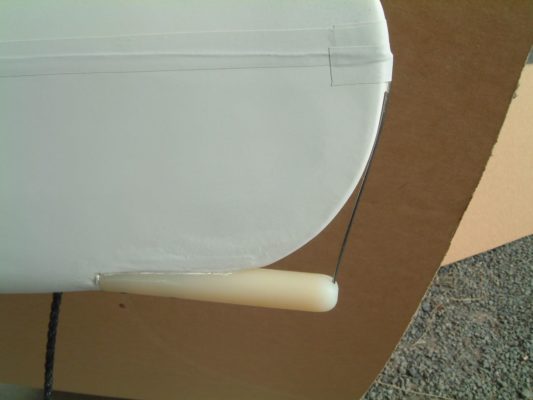
Evolution Omega Bifurcated (Bifid) Bow
Change #2 was to lengthen an Edge hull 200mm BEHIND the cockpit – making it very ‘bow-down’ on the water. The original testing prototype was created and tested in 1995 – then destroyed in the factory fire in 1996. Testing conclusion – even better ‘run’ and more stable than the Edge.
Some would expect this new longer Omega hull to be wetter for the paddler. WRONG. The Bifurcated Bow acts as a shock absorber. As the bow slams down onto the next ‘green-water’ wave, the Acetal plastic rod exhibits downwards drag. The Evolution Omega is in fact the driest Evolution model on big wavetrains. But hey – this advantage is also reported by bulbous bow ships crews.
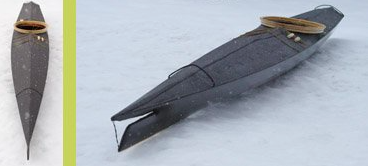
Extreme wave-piercing
Read more (second item from the top) here https://www.sissonkayaks.co.nz/blog/advice/frequently-asked-questions/
So – you may ask – is this new Evolution Omega faster? Multisport kayak performance is as much about ‘greater-distance-made-good-for-lower-fuel-burn’ as it is about ‘speed’. But hey – this advantage is also reported by bulbous bow ships crews.
Evolution Omega testing has taken place on the Rangitata Diversion Race (RDR), just over the fence from our Methven factory. Luke Vaughan has compared his Edge to his Omega over many 700 metre runs at 130 HBPM and 160HBPM
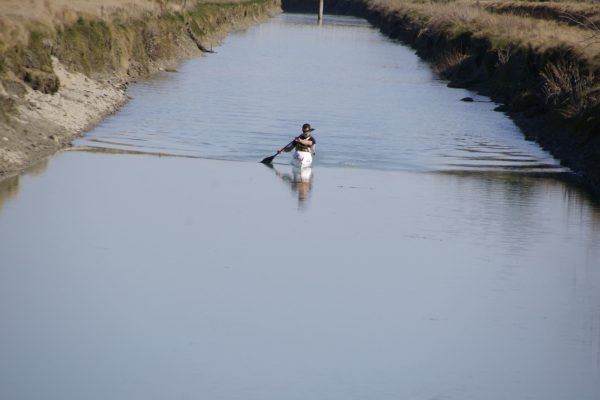
Evolution Omega with bifid (bifurcated) bow
Note reduced bow and stern wakes
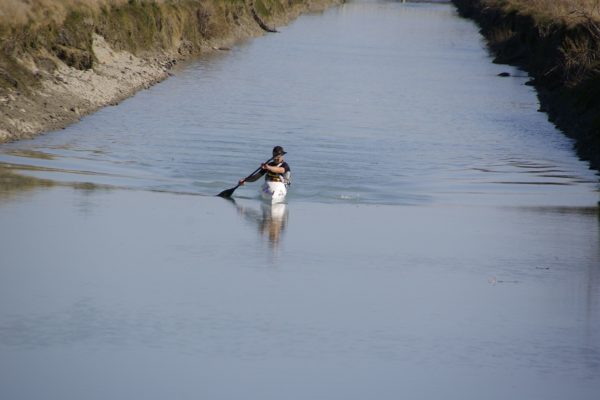
Evolution Omega
Hardly a footprint – in fact the paddle dips are almost the greatest disturbance.
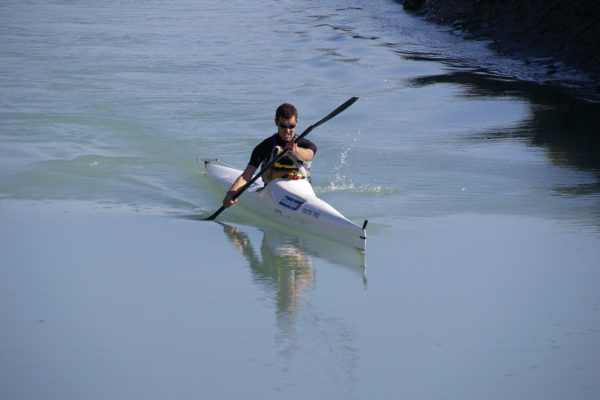
Evolution Omega close up
Strangely my biggest marketing nightmare has been one that I did not anticipate. How to convince my Evolution Classic and Edge customers that their beloved kayaks were partly obsolete? Slowly they came to believe my predictions. They ordered Omega kayaks.
All Omega customers have reported better than expected stability. Some, including Gordon Walker have been able to set their seats higher in order to achieve better paddling dynamics.
All Omega customers have reported better “run” between paddle strokes.
All Omega customers have reported drier paddling through big water.
All Omega customers have reported shorter paddle times on known courses (speed – how I think that word is miss-used when kayaking is just one multisport segment of a potential hit-the-wall race).
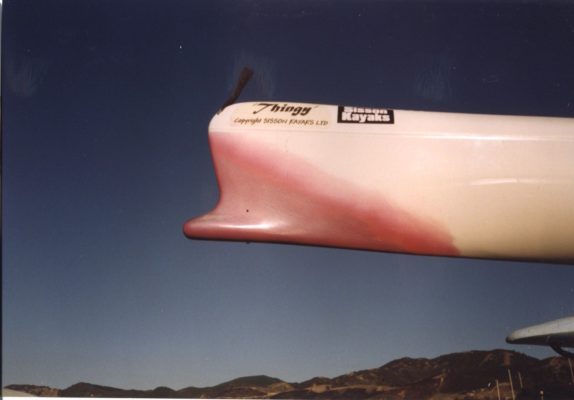
Sisson Kayaks has experimented with Bifurcated (Bifid) Bows for many years. On this Esprit the bow wave moved closer to the hull. The paddle ‘catch’ happened earlier – on top of the bow wave instead of ‘inside’ the bow wave. Double advantage.
The Evolution Omega – paddled by Gordon Walker when he won the 2010 Speights Coast to Coast race – and set the fastest 2010 Longest Day paddle time. The Evolution Omega – paddled by Dougal Allan when he came a close second to Gordon. Gordon is a man of few words. “Awesome” will suffice.
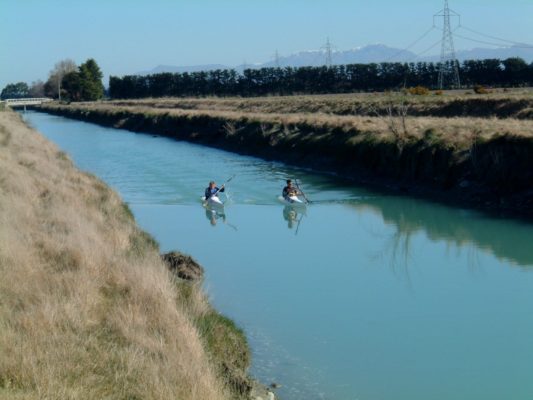
Basil Pettigrew (left) Omega and Luke (right) Edge – at 130 heart beats per minute

Same photo enlarged. Surely you can see the difference!
And now – the science – a simulation – thanks to the computer work of the French naval architect, Marc RONET http://marc.ronet.free.fr/index_eng.html
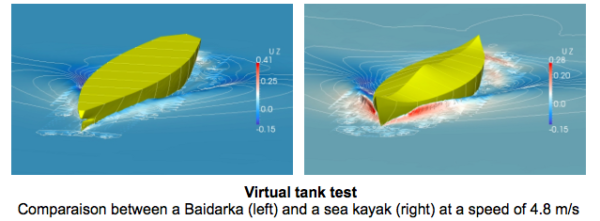
The science matches the actual. Study the photo above again – closely. In this simulation the Baidarka has the Bifurcated (Bifid) bow.
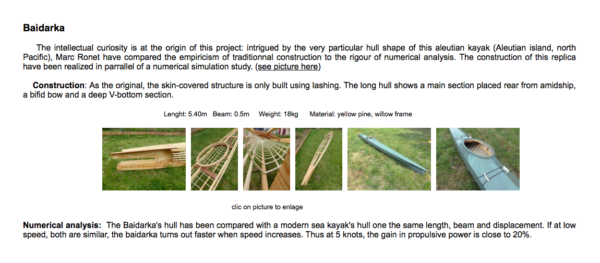
From the website of Marc Ronet. Link to this project is here
“Kayak”, “Kajak” or “Baidarda”? Click here for an explanation.
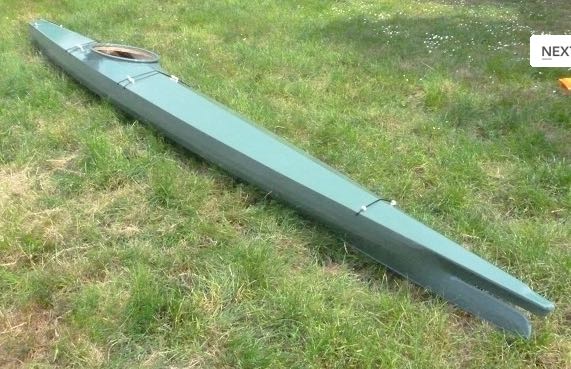
Wow! Marc Ronet’s wonderful baidarda kayak kajak Iqyax project.
2018 Bulbous (Bifid) Bow Update
The Polynesians used this technology too…..
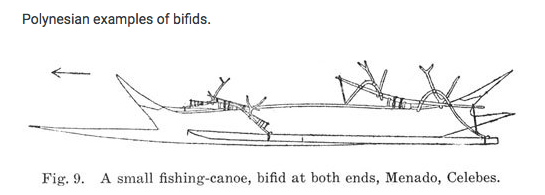
At the time I decided to try bulbous (inuit bifurcated) bows on kayaks, the ship designers knew it worked – but the science had not been resolved. In 2017 the science seems to be more advanced – whilst stating bluntly it will never work on a small pleasure craft like this:-
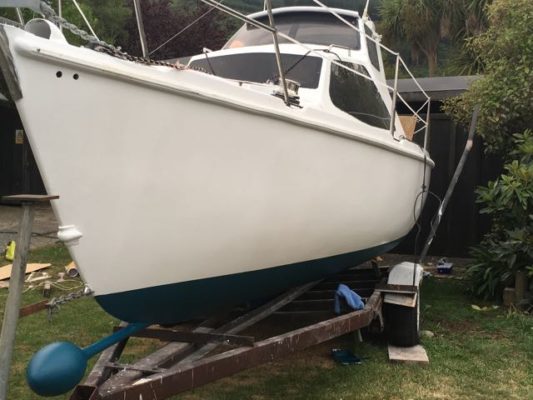
Note the ‘Rugby-Ball’ design stolen from a recently launched aircraft carrier bow
Results – From not believing the ‘small-boat’ science
- Maximum speed of 13.1 kph unchanged
- Throttle back to 1/3 power-setting – the cruise speed is still 11 kph.
- 7.5 kph at engine idle. Terrifying overspeed approaching jetties and moorings.
- Improved straight-ahead course setting – zero wandering in any conditions. Rudder drag reduced.
- Less ‘pitch-and-pound’ driving into big waves. Wetted-area drag reduced
- Bow less likely to ‘blow away’ approaching jetties.
- Huge fuel savings at 11.5 kph cruise speed.
- It works!
In retirement – having constructed zero Evolution Omega kayaks for many years (retired) – I have this to say. One day the ‘Kayak-Industry’ will ‘wake-up’. Bifid (Bifurcated) bows will be everywhere. They will have done their ‘research’. By reading (and copying) all of the above. From the Sisson Kayaks website.
Sheep
Predictable – based on actual history.
Posted in: Multisport Racing Kayaks
Evolution EXTREME Racing Kayak
Date: May 21st, 2017
December 2019. Production continues in Winton. Email Rikki Griffin – rikki@nautiquekayaks.co.nz – find out more.
(Optimised waterline length for 60 kg paddlers)
How did this kayak Evolve?
In 1995 our factory manager Andrew Pfahlert (60kg light) needed a fast boat to use in the Portage Race. His custom built one-off boat (fabricated from bits of this kayak and that kayak) worked so well that a decision was made to made production moulds off the design. So Andrews’ one-off special lives on for others to experience.
Warning: The Evolution Extreme is designed primarily as an open-water go-fast boat. It may be used on wild rivers but is more prone to ‘boil grab’ due to the straighter keel rocker.
The Evolution Extreme hull water-plane is designed around a different criteria to that used for the Evolution Classic and Evolution Edge which are primarily designed as river boats that also work very well on open water.
At the waterline the Extreme has a ‘diamond’ water-plane form similar to, but longer than, that used by most top K1 racing kayaks. The ‘diamond’ water-plane results from the bow lines running directly to the widest point at the cockpit and then returning directly to the stern. This hull configuration whilst being proven to be very fast in anaerobic paddling intensity, also produces a wider cockpit area than the other Evolutions are able to offer. This wider cockpit coupled with fine ends allows the Extreme to be settled to full waterline length by paddlers as light as 60kg. As stated above, this kayak is usable by any paddler of any weight who can fit the cockpit.
Note:
We state above that the Evolution Extreme is optimised for 60kg paddlers. This means a 60kg paddler will press the kayak draft deep enough to obtain full waterline (speed potential) length. The Evolution Extreme can in fact be paddled by any paddler who fits the cockpit which is the widest of all the Evolution models. The Evolution Extreme has been used by many (big brute) athletes such as Olympic Gold Medalist Ian Ferguson to set many ‘open water’ race course records.
Posted in: Multisport Racing Kayaks
Evolution EDGE Racing Kayak
Date: May 21st, 2017
December 2019. Production continues in Winton. Email Rikki Griffin – rikki@nautiquekayaks.co.nz – find out more.
(Optimised for paddlers up to 75kg)
How did this kayak Evolve?
At the time that Steve Gurney and Grahame Sisson designed the kayak that we now know as the Evolution Classic, the rough work-of-art shape (plug) more closely resembled the kayak we now know as the Evolution Edge. Suffice to say that between the initial shape development and the creation of the first boat (Steve’s) the boat became wider and more stable. The final shape was not exactly what Steve had in mind. It was a boat that Grahame (and a wider customer base) could also paddle!
So, in order to restore a good friendship, we next created the boat that Steve thought he was getting in the first place. We called this boat the Evolution Edge. The first production Evolution Edge left our factory in October 1992.
When the heat came on Steve at the 2001 Speights Longest Day, he sought every advantage he could find. He chose a carbon Edge and used it as a weapon on the river. Going onto the river Keith Murray (even record holder) had a commanding lead of around 10 minutes. Keith was 50 metres behind Steve at the Gorge Bridge. Steve paddled the river 6 minutes faster than any other event (including Two day teams and Individuals) competitor. Viva La Edge. Steve is delighted that the Edge really gave him an EDGE. It took a while but at last Steve has used effectively the weapon he helped design 12 years ago.
The Evolution Edge has finer entry, 35mm narrower footrest, is 25mm narrower at the seat and generally lower volume. The narrower water-plane allows lighter paddlers to press the hull to deeper draught, thus achieving maximum waterline length.
Over the years many paddlers have won many races using Evolution Edges. A skilled fresh paddler using an Evolution Edge is a hard competitor to beat.
- Witness Steve Gurney – fastest paddle overall, 2001 Speights, by 6 minutes! Steve beat Teams kayak specialist Paul Massey by 9 minutes. Not an error – 9 MINUTES! Steve is just delighted with his new boat!
- Witness Andrew Martin of Andrew Martin Kayaks. For Multisport events through the 2001 season Andrew paddled an Advantage, Sprinter, Pinnacle, Evolution Edge. These days Andrew builds Legend paddles and is free to choose the best boat.
- Witness Graeme Causer taking out the fastest paddle at the 1997 Kaniere Tri.
- Witness Ian Ferguson and Neil McConnell battling for 1st place on the water at the 1996 Crater to the Lake.
- Witness Neil McConnell repeatedly winning paddle sections of many races.
- Witness John Jacoby’s many wins at the (Vic, Aust) JLL Challenge.
- Witness Peter O’Sullivan who dares to beat other top paddlers by ridiculous time percentages. Peter has encouraged large numbers of Manawatu paddlers to also purchase and race Edges. Witness the 2001 Rangeitiki Kayak Race results.
Which Evolution is best for you?
Sorry – that is your choice. For the Speights Coast to Coast Longest Day, Steve Gurney used to prefer the extra stability of the Evolution Classic. However for the 2001 event Steve has a brand new Edge which helped win him the race. For almost all of the races Peter O’Sullivan competes in, he uses an Evolution Edge.
Our high-skilled multisport customers have a true choice.
In July 2003 Ben Fouhy (World 1000k Sprint Champion) wrote:
“Thanks for your consideration”.
“In response to people saying that I would win (multisport racing) in any boat, my answer is that it is likely true, yet I can paddle any boat, having been offered an F1 in the past, having access to a UFO and an Advantage, but I have CHOSEN to paddle an Evolution Edge.”“Often people ask me my opinion on the differences between the top boats, and this is my opportunity to expel the virtues of your boat design, as people have sought my opinion, this happens very regularly”.
“I believe that the Edge or Classic is the boat of choice because in my opinion there is a difference between maximum speed and boat run. While the Evolution, being a larger boat might not be a fast boat over a 500m race which is totally irrelevant (and debatable), in my experience it has more boat run, distance per stroke. Making it more economical to paddle over a distance race.”
“I genuinely believe the Evolution was well ahead of its time, having similar qualities in hull shape to the latest K1’s in Europe having very even curves from front to back and the U shaped hull gives good run.”
The volume in the top deck and the boat in general is advantageous on rivers and sizable rapids, especially the Waimak, as I have found with lower volume boats lose speed very quickly when the water comes over the top.”
“I have experienced this paddling down the Waimak with lesser paddlers who I have thrashed days earlier on flatter rivers, then been frustrated as I haven’t been able to pull away from them.” “That is why I have chosen your boat.”
Note:
We state above that the Evolution Edge is optimised for 75kg paddlers. This statement means a 75kg paddler will press the kayak draft deep enough to obtain full waterline (aerobic speed potential) length. The Evolution Edge can be effectively paddled by any paddler who fits into the (in its class) roomy cockpit.
The Evolution Edge is primarily designed as a riverboat for use by high-skilled paddlers. As a bonus the Evolution Edge also works very well on open water.
Posted in: Multisport Racing Kayaks
Evolution CLASSIC Racing Kayak
Date: May 21st, 2017
December 2019. Production continues in Winton. Email Rikki Griffin – rikki@nautiquekayaks.co.nz – find out more.
As used by Keith Murray to set his 1994 Speights Coast to Coast Longest Day record.
(Optimised for paddlers 75kg upwards)
How did this kayak Evolve?
The Evolution Classic was developed (under extreme pressure from the visionary demands of Steve) over the Christmas close-down period of the 1988-89 summer. Steve set the requiered length and volume needs. The rest of the design was 50% / 50% Steve / Grahame with Steve arguing for the water and Grahame arguing for the wind. The whole object of the exercise was to help Steve win a BMW car by breaking the Speights Coast to Coast Longest Day record. It is a matter of record that Steve Gurney did win that BMW – by turning out an amazing paddle performance.
Since those early days, using an Evolution Classic, Steve has won the Speights Coast to Coast many more times , sometimes taking out the ‘FASTEST PADDLE OF THE EVENT’ prize for good measure. He has also won hundreds of other races, thus cementing his position as the worlds greatest multisporter.
In early 1990 the Evolution Classic started a unique New Zealand phenomenon – the ‘Long Boat’.
Often copied – not yet equalled! Except by our Edge!
The current Speights Coast to Coast Longest Day course record of 10 hours 34 minutes was set by Keith Murray in the 1994 event. Keith used a 17kg (he wanted durable reliability!) Evolution Classic for the kayak paddle section. Durable – Keith still paddles this same robust kayak in Dec 2000 (finally written off in the Rangitata Gorge in 2001) and is emphatic that, for endurance events, ultra light kayaks are not the advantage that some would claim. Keith’s record stands secure. So does his practical race winning strategy!
Posted in: Multisport Racing Kayaks
Esprit Racing Kayak
Date: May 21st, 2017

Utopia
December 2019. Production continues in Winton. Email Rikki Griffin – rikki@nautiquekayaks.co.nz – find out more.
Imagine – a ‘beginners boat’ that is so potentially fast – it has actually been used by strong paddlers to win real races! This is it – the Esprit!
We often wondered what would happen if a strong, skilled paddler used one of our stable ‘beginners boats’ in a real race. Now we know. They win! Scroll down to read about Geoff Mathews’ and Ron Wastneys’ amazing race results. Sure – Geoff and Ron wounded a few egos by beating lots of ‘top’ paddlers in all sorts of ‘fast’ boats. Proven – these wounded ‘top’ paddlers were sadly using kayaks that are too ‘fast’ (unstable) for their true abilities. They should all have been paddling Esprits! It is an unfortunate fact that ‘fast’ kayaks look much better on the car roofrack than ‘stable’ kayaks such as the Esprit.
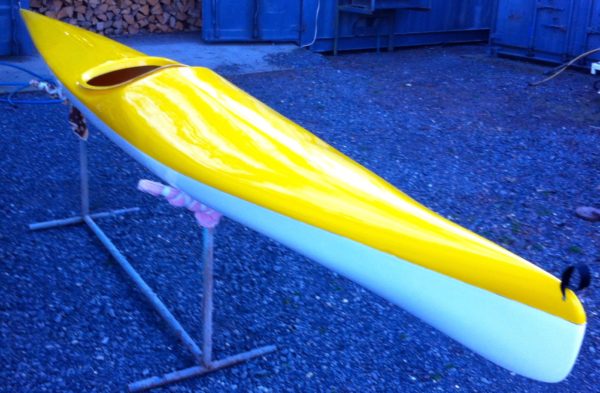
If distance-made-good from low fuel-burn is important – get yourself a stable Esprit
So – if you are honestly looking for a stable kayak that can grow with your power and skill increases over time – you should consider an Esprit – the ‘beginners boat’ with proven race winning performance!
Details of the real races won:
As newcomer multisporter Geoff Mathews placed his Esprit kayak onto the beach before the 1994 Thermatech Head to Head, some competitors openly laughed (“we will mow him down”) at his kayak choice. Geoff had been paddling kayaks for less than four months. He wisely chose a kayak that suited his kayak skill level.
It is now historic fact that Geoff achieved a fast run and cycle which placed him first individual onto the water. He was hotly pursued by highly ranked kayakers paddling narrow potentially fast boats. Right down the harbour Geoff was in view. They gained very little ground on the ‘novice’ in the ‘laughable’ boat.
Geoff won the race! Geoff gave much credit to his Esprit.
At the 1997 Waimak Classic River Race, ‘unknown’ Evolution Classic paddler Ron Wastney chose to test an Esprit for speed on a real river in a real race. His race result time included time taken to rescue another competitor who was in difficulty.
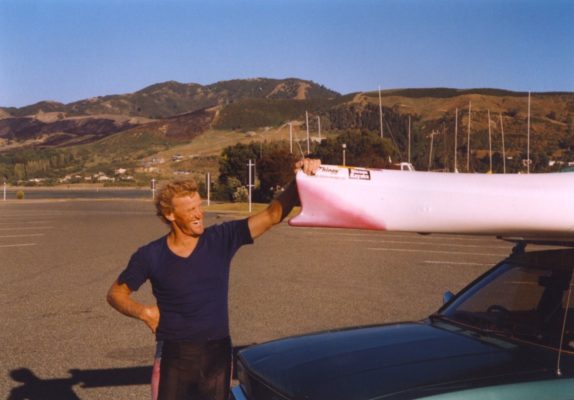
Ron with his Bifurcated Bow Espit. Which the ‘market’ decided did not work. Which only enhanced Ron’s ability to emulate a top-paddler
Ron and his Esprit not only beat all other competitors in his race class, he also beat all other competitors in the race class above. This higher race class included racers in Eclipses, Sprinters and Arrows! In fact, ignoring all race classes, Ron came seventh overall. In achieving this high ranked race result, Ron showed the Esprit to be capable of faster speeds than all other similar kayaks from all other brands. Ron also beat a large number of ‘hotshot’ racers in long ‘fast’ boats.
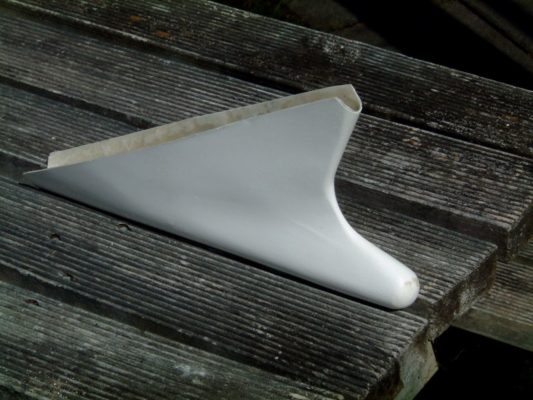
Sisson Kayaks developed this aftermarket bulb to fit existing Esprit kayaks. Market fail – proving that New Zealanders have some deep-seated sexual hangups. Whilst paddling slower! Unbelievable! ‘The Market’ states “It does not work anyway!”

YEAH RIGHT! ‘The Market’ – are those ‘knockers’ who can write their lifetime contributions to mankind’s progress – on the back of a postage stamp! Quote – Grahame Sisson
Once again – the Esprit was proven to be capable of incredible performance – provided the paddler had the experience to extract it.
In recent years, during many Speights Coast to Coast events, hundreds of our Esprit customers have paddled the Waimak river dry and warm, bemused by the river carnage caused by the masses of swimmers struggling for the shore towing their swamped 500 kg “lightweight” “fast” kayaks. Get wise – paddle an Esprit! Get the experience!
- The Esprit is truly fast and stable in real race conditions.
- The Esprit resists shallow water bottom drag. The forward volume resists ‘crash-diving’ down river eddy lines and stopper holes.
- The Esprit has ample foot and leg room to ease the pain of stiff legs.
- The Esprit is much less likely to break when piled onto the rocks. That’s because the Esprit, like all Sisson Kayaks has up to 46000 unidirectional glass fibres along its keel.
- The Esprit stays on course in high winds.
Posted in: Multisport Racing Kayaks
Eliminator 97 Racing Kayak
Date: May 21st, 2017
December 2019. Production continues in Winton. Email Rikki Griffin – rikki@nautiquekayaks.co.nz – find out more.
Michael (who) Jacques, writer, once stated “The Eliminator is only just fast enough not to be laughed at”. Hahahahahahaha from Grahame.

2009 Luke Vaughan 700 metre RDR test @160 hbpm
Evolution Omega 2 minutes 48 seconds
Eliminator 3 minutes 5 seconds
Clearly the Eliminator is not slow. In 2018 the Eliminator is still sought after. Not so sure about the opinions of the above failed writer.
In 1991, using Steve Gurney as a ‘motor’ at 160 hbpm we tested many of our kayaks against a constant heartrate (equal power) and using water pressure manometer to register speed. The Evolution Classic pushed a pressure of 11 on our scale. The Eliminator pushed 9. Steve and I were staggered – it seemed too fast. The conditions were calm on Nelson harbour. Same result when we re-tested the Eliminator. This kayak goes very well with a strong motor!
On Friday 14th May 2010 we retested the Eliminator using GPS and Luke Vaughan as a motor at 130 hbpm. The conditions were calm. The Rangitata Diversion Race was flowing a constant rate to the power station. The measured course was 700 metres long.
The Evolution Omega runs averaged 2 minutes 49 seconds. The Eliminator was tested at just 16 seconds slower. SIXTEEN SECONDS off One hundred and sixty nine SECONDS! Barely worth working out the percentage loss if this had been a rough and shallow river course.
There are also two other ‘hidden’ Eliminator ‘real-race’ gains to be had. The Eliminator has a real DRR type bow. The deck will stay drier in big water – meaning less drag. And the hull draws less draft than an Evolution – so it will still be floating when the narrow hulls are dragging stones. Maybe in real terms the difference would only be 10 seconds over 700 metres of flowing water!
Michael Jacques – he quite clearly needs some paddling technique lessons. No-one likes to be laughed at. He ‘fitted’ people up – needlessly influenced them – for reasons best known only to himself – so that they purchased narrow ‘needles’ that launched them into a different sport as swimming stars. Many did not come back for a second session. They enjoy the fine art of breathing air too much.
We have so many happy Eliminator customers who would know that Michael wrote his stupid article based only on personal bias. Michael – stick to running advise in future. It could be argued that Michael played a strong role in the gutting of a great sport – Multisport.
Many years ago, Iron Man Geoff Mathews and yachtsman Grant Dalton had a grudge race at the Whanganui Descente race. They were both kayak beginners in Eliminators. Guess what? They cleaned out most of the field completing a 90 minute (winners time in Evolution) section only five minutes off the pace! Further proof real performance.
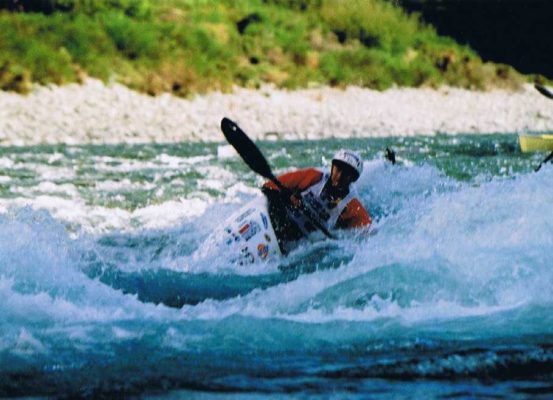
My bank manager – caught in traffic – forced over this – did not swim
When Nathan Fa’avae lived at Anakiwa he reported that his paddling times to Picton were almost the same in his Evolution Classic and his Arctic Raider. The Eliminator uses an Arctic Raider hull form. More proof that provided the Eliminator paddler has good and strong technique, it will perform at a high level.
We have built more than 1000 and less than 2000 of these most popular boats.
Pre 1996 Eliminators are not quite as well designed for wing paddle use as the Eliminators we build now. For the 97 version we retained the famous ‘Fishform’ hull. The deck has many slight improvements aimed at providing a better, more powerful paddling position and much improved comfort and ergonomics. There is more foot room so that running shoes can be worn. There is even more knee room so that the knees can be worked to get more power from a wing paddle.
How does our new Eliminator 97 look on your roofrack? Racy!!!
What’s in a name?
Eliminator the ‘beginners’ boat that wants to go faster than it should. Proven performance by non-swimmers over so many years.
Currently our top selling ‘beginners’ model. Proof that dedicated non-swimmers are getting into multisport.
Posted in: Multisport Racing Kayaks
Drink Tube Upgrade
Date: May 21st, 2017
The stainless steel tube is bonded into the side of the bottom of the hull below the waterline. A hull is then precisely drilled. Drinking water can then be drawn from the river. This weight saving device was pioneered by Steve Gurney for use in the Waimakariri River while he was winning the Speights Coast to Coast. Not recommended if the water being paddled on is undrinkable. Not recommended on European or North American lakes or rivers! Only in clean-green (parts) New Zealand!
Posted in: Kayak Upgrades
Defender Racing Kayak
Date: May 21st, 2017
December 2019. Production continues in Winton. Email Rikki Griffin – rikki@nautiquekayaks.co.nz – find out more.
Multisport, the New Zealand invention is now a rapidly developing sport overseas. In Australia the sport commenced several years ago with the advent of the Subaru Classic race series. Steve Gurney won several cars using a Sisson Kayaks Infinity. One reason Steve did not use his larger Evolution kayak was due mainly to the fact that it is very difficult to travel overseas with such a long boat.
For export reasons alone, we needed to develop an Evolution type kayak that would fit inside a 20ft container. In addition, our market research has shown the need for a large kayak that is midway between the Evolution Classic and the Esprit in both performance and stability.
We call this the Defender.
- The Defender is the optimum kayak for the multisporter who needs a compact ‘Evolution’ style boat. The shorter length also allows for easier car-topping and in-garage storage.
- The on-water performance of the Defender in a river will be slightly less than an Evolution Classic. On open water the performance will prove to be very similar.
- The primary stability of the Defender is less than an Esprit and more than an Evolution Classic.
- The Defender is styled in the same manner to the Evolutions. In all respects the Defender is similar to the Evolution Classic except it has a shorter length and a wider beam at the waterline. The available space in the cockpit is larger and more spacious at seat level. Paddlers with wider bottoms are able to use lower seating arrangements thus accentuating the already good stability.
- The Defender is only available constructed in Kevlar lay-up.
Posted in: Multisport Racing Kayaks
Centrix Racing Kayak
Date: May 21st, 2017
December 2019. Production continues in Winton. Email Rikki Griffin – rikki@nautiquekayaks.co.nz – find out more.
“At the end of the day it’s the width of the footrest that indicates the stability of the boat as it plunges into a ‘hole’ in the river”
The Centrix bow offers a finer entry into the water and the overall beam at the widest point of the hull is 480 mm. The beam at the seat is 25 mm narrower than the Esprit whilst the overall water-plane still retains its race-proven “Fishform”. The 5.075 metre overall length minimises the wetted area, frontal area, beam ratio which ensures that the Centrix is a true step up in performance from the Esprit.
This performance increase has been confirmed by our customers feedback as well as comparative tests done by New Zealand Multisport Magazine. They summed up “If you’re happy in an Esprit you’ll definitely be happier and faster in a Centrix”. That says it all!
Posted in: Multisport Racing Kayaks
Carbon Fabric
Date: May 21st, 2017
In final layer of lay-up – Evolution & Nucleus models. Makes for a stiffer hull that retains the design shape better when the kayak is pushed hard by top paddlers. Increased speed is likely. Not of any advantage to ordinary paddlers. Sorry – not available for export orders due to carbon damaging easier than Kevlar and also being a lot more expensive to repair.
Select on dropdown extras menu in quote form.
Posted in: Kayak Upgrades
Camlok Buckles (pair)
Date: May 21st, 2017
For adjusting steering cable length
Posted in: Kayak Spares
Bulldozer Footrest
Date: May 21st, 2017
Sidebars SK125 (shown in photo) and fastenings are not included. If required – order sidebars as a separate spare part.
Full description of this footrest advantages / disadvantages are listed on previous page.
Posted in: Foot Rests, Kayak Spares
Bar-Type Footrest Side Bars
Date: May 21st, 2017
Bar-type footrest side bars with fastenings.
Sidebars are precision drilled with nineteen 5mm holes to allow footrest adjustment range.
These sidebars are needed to mount SK120, SK121 and SK122 bar-type footrests to a kayak
Posted in: Foot Rests, Kayak Spares
Bar-Type Footrest Fastening Stainless 5mm Pan
Date: May 21st, 2017
Pack of 10 spare bolts and nuts.
Posted in: Foot Rests, Kayak Spares
Astrolab Sea Kayak
Date: May 21st, 2017
December 2019. Production continues in Winton. Email Rikki Griffin – rikki@nautiquekayaks.co.nz – find out more.
Our Eliminator customers demanded the Pepin.
Now our Esprit customers demand the Astrolab as a go-fast, budget sea kayak that knocks the socks off (faster than) any ‘Tupperware’ boat of similar value. On land this kayak is light enough to carry your paddle in one hand and the kayak in the other – just try doing that with most similar priced ‘plastic’ sea kayaks!
- Are you a Multisporters who lives near protected open water?
- Are you forced into training on your own?
- Do you dabble in kayak camping?
- When it comes to rivers, do you mainly paddle those like the Wanganui?
- Do you already own a heavy, high-drag plastic sea kayak?
If you answered “Yes” to one or more of these questions, an Astrolab could be the boat for you. Such a purchase could save you thousands of dollars.
The ASTROLAB is a sea kayak version of the ESPRIT.
- The hull through the mid-section is strengthened against impact by adding two extra unidirectional roving beams of 23000 fibres each.
- Two bulkheads are glassed in from both sides to seal the ends into compartments. The reserve buoyancy of a tipped over and flooded Astrolab is very high. Hatches are fitted to these compartments so that camping gear can be carried.
- Decklines are fitted so that solo self rescues can be undertaken with confidence.
- The Overdeck rudder is the same rugged unit used on thousands of our multisport kayaks since 1986.
- Refer “Pepin” page for more details on the features of the Astrolab construction and fit-out.
When compared with other manufacturers offerings in this niche, the Astrolab out-performs them all on both performance and price.
Posted in: Sea Kayaks
Arctic Raider Sea Kayak
Date: May 21st, 2017
December 2019. Production continues in Winton. Email Rikki Griffin – rikki@nautiquekayaks.co.nz – find out more.
We wanted to create a more stable, user friendly boat that offered our customers all of the advantages of the NORDKAPP.
It turned out to be faster and more stable.
In the beginning there was the Nordkapp. It was the first European attempt to commercially market a modern kayak along the lines of the ‘West Greenland’ models used by the local Inuit people.
Of all the Inuit, the West Greenlanders had to hunt in the roughest, most wind exposed open waters. These sea conditions are really quite similar to those found in New Zealand. Therefore any kayak design which served the West Greenlanders well, will also be expected to serve New Zealanders well. The success of our customers, in meeting their paddling goals over the past 20 years, confirms this observation as fact.
The Arctic Raider was designed to maximise the West Greenland design type in such a way that the maximum spread of paddlers will enjoy their paddling experience no matter how bad the weather turns.
So what is a West Greenland style kayak? The hull has three distinctly separate sections.
- The central load carrying (displacement) section is profiled to provide good stability and low water resistance drag.
- The bow hull section is of a triangular configuration with the two sides providing a dynamic parting (cleaving plus some lift) of quite high waves.
- The stern hull section dissimilar to the bow but more styled to allow a longer waterline length (speed).
Couple all of this with the smooth deck layout that is totally styled to shed water and offers the very minimum of wind force against the paddlers chosen course. It also has a very low floodable cockpit area due to the original ‘pod seat’. The seat forms a bulkhead which makes for three dry compartments closed off by three solid moulded ‘Real’ neoprene rubber hatch covers.
The Arctic Raider was the kayak of choice for their 1994 East to West traverse of New Zealand. Read Richard Ackerley’s book ARAHURA* and you realise how tough we build our sea kayaks.
*ARAHURA is published by The Ackerley family, 35 Davis Rd, R.D. 2, Hastings NZ Phone 64 6 876 6968.
Of the hundreds of Arctic Raiders that we have built, more than half of them have been sold in Japan. It is therefore fitting that we should quote a satisfied customer from that country. Japanese paddler Takehiro Shibata, when planning his solo trip around Norway from Sweden to Russia, specified a custom built Kevlar Arctic Raider that ranks as the strongest kayak yet created at Sisson Kayaks. His feedback on completion was “thank you for such a good boat”.
Takehiro’s was custom built. In effect all Sisson Kayaks are custom built.
Warning: The production of Australian manufactured Arctic Raider kayaks is in no way associated with Sisson Kayaks. The original design did derive from a mould sold to Canoe Sports, but very quickly the ‘deal’ unravelled. If you live in Australia – want a real Arctic Raider – deal with us! Get the original – not the glitz (“my hatches are bigger than yours”) copy!
Posted in: Sea Kayaks
AMK Seat
Date: May 21st, 2017
Composite racing type pan bolted to composite brackets glassed to the side of the hull just below the seam join. Preferred by some top racers including Andrew Martin who gave me the shape to use.
Form-fitted at the time the kayak is built.
Posted in: Kayak Upgrades
AMK Hanging Seat Kit for Evolution Models
Date: May 21st, 2017
Hanging seat kit for Evolution Classic, Edge, and Extreme.
Complete with hull fittings (needs fibreglassing skills and materials), and fastenings.
Posted in: Kayak Spares, Pan Seats
290mm Neoprene Hatch Cover
Date: May 21st, 2017
to fit Large Hatch Upgrades. Upgrades may be found on Voyager, Arctic Raider, Nordkapp, Pepin and Astrolab. Made in New Zealand to our specification.
Posted in: Hatch Covers, Kayak Spares
210mm Neoprene Hatch Cover
Date: May 21st, 2017
to fit 1970’s Nordkapps, all current Pepins and Astrolabs. Made in New Zealand to our specification.
Posted in: Hatch Covers, Kayak Spares
‘Real’ Moulded Hatch Cover
Date: May 21st, 2017
Fits all Nordkapp, Arctic Raider, Southern Light. Voyager, models with standard hatches. Fits any Valley Canoe Products ring on hundreds of different kayak brands. Fits Quality Kayaks Sit-On-Tops and many other QK sea kayaks.
Manufactured from OZONE and UV resistant rubber.
Posted in: Hatch Covers, Kayak Spares
2014 retirement-hobby kayak construction
Date: April 17th, 2014
Hi
In about 8 weeks time Mt Hutt will be open and we will once again be based on our Methven farmland – which is where the kayak factory is located. I am building less kayaks than last year. Over 50% of the planned build slots are now taken with firm orders. Old returning customers take top ranking because they are so easy to deal with – they always know what they want.
Prices listed below. Email me grahame@sissonkayaks.co.nz
It is essential that I never have the feeling of being in business again. I still enjoy the manufacturing process – and it has to be fun. All promised delivery times are based 100% on historic Mt Hutt ski field closed days! Weak promise!
Posted in: News
2013 Retirement-hobby kayak order book now full
Date: July 19th, 2013
The orders flowed in!
Thank you.
Anyone else wanting a new Sisson Kayak – please keep checking the website to see if I make a similar offer in 2014. Or email me – you never know.
Posted in: News
The new beginning? Retirement hobby kayak production starts.
Date: June 6th, 2013
It is 15 months since I last cranked up the WordPress machine to update my Sisson Kayaks website.
Lynda and I have enjoyed the 18 months since I locked up the kayak factory. In that time we have :-
- Greatly enjoyed the complete absence of daily ‘pressure-to-perform’ – as we have done for the previous 38 years.
- Wound up the company – Sisson Kayaks Ltd.
- Dismantled all of the business overheads – and returned to the settings of 40 years ago – when the business started in ‘The Shed’ – as a hobby.
- Pondered “what-if-we-take-the-locks-off-the-kayak-factory-doors-again”
The kayak factory is still 100% operational. One snag though. We choose to live six hours drive away for eight months of the year. For the remaining four months we live right beside the kayak factory.
Why? The factory is located on farmland that is our winter holiday-home at Methven Mt Hutt Village. Yes we relocate to Methven – because we ski – and ski – and ski.
Over the past 6 months several loyal customers have ordered new replacement kayaks off my new hobby business. I will be making low numbers of kayaks in Methven this winter – in between the skiing.
This is your chance. If you want a new Sisson Kayak built between mid-June 2013 and mid October 2013, contact me on 027 2755 499 – or email me at grahame@sissonkayaks.co.nz.
This offer is make only to real customers – who know about kayaks – who largely know what they want – and do not refer to the paddle as “an oar”. All others can buy their kayaks from the nearest branch of the Warehouse!
And now the good news. We live in times of low inflation. Currently many of the items I personally desire to own – are subject to deflation – the prices drop. My new 2013 kayak price list suffers from deflation too.
This lower kayak price-list is possible because operating as a ‘hobby’ means much lower overheads. We still pay our taxes. But not GST (except on our raw materials). Because kayak production costs contain heaps of LABOUR – my retirement hobby customers are the price-deflation winners
Request a factory-fresh-new-kayak quotation. Email grahame@sissonkayaks.co.nz or phone me on 027 2755 499.
Posted in: News
“What are you doing with the kayak building stuff?”
Date: February 19th, 2012
No idea. Absolutely no idea. We still own the Methven farm land. We still own the factory and plant. The Methven land is now where our ‘bach’ (holiday home) is situated. Mt Hutt season passes came on sale two days ago – bring it on.
The fibreglassing shop where the kayaks were moulded is the same as it always was – 120% operational. The kayak fitout and office areas are now converted for other use – but the fitout area will be set up in a smaller area shortly. Fully operational kayak factory – just locked up. Nothing has been sold.
The company named Sisson Kayaks Ltd is being wound up. The assets will then become the property of the shareholders. The retired ones!
Maybe my retirement will become too boring. Who knows what will happen in Methven. My current retirement hobbies include making things for myself from metal, timber and fibreglass. Keeping my skills up.
Posted in: News
This website – what future?
Date: February 18th, 2012
We are retired. Yeah right! We are still very very busy. And we move into retirement with heaps of options because we have sold off none of the assets that we have accumulated over the past 45 years. Options galore!
This Sisson Kayaks website will continue to exist. As a place to supply spare parts to old Sisson Kayaks owners. And who knows – it may even be expanded in slightly different directions.
Who knows what the future holds. The global banking industry looks bleak. The list of countries that may decide to default on their ‘bonds’ is huge. So many previously affluent ‘middle-class’ people have to now plan different routes to the future.
Kayaking always was the most affordable way to get afloat. That will continue. The market is glutted with commodity cheap plastic stuff. There will always be a need for real kayaks that perform and endure for decades.
This website will continue. And I will be more active in future. Because I will have more time available. Honestly – I will try to keep some topical stuff here.
Posted in: News
Sisson Kayaks spare parts supply
Date: February 18th, 2012
Very sorry to those customers who ordered parts over the past 6 months. Your orders were ignored. Very sorry.
After 38 years in business (36 making kayaks) we have rejoiced in the freedom to pursue many personal interests – some of which had been pushed to one side for too many years.
In addition the closing down of the kayak company – and all of its monthly overheads – has been a big job.
When we closed the business at the time Mt Hutt closed – the Methven office and the kayak fitout area were dismantled. All of the kayak parts were placed in storage. Until March 2012 the problem has been – where can these be stored in an accessible space? Space has now been made at our Anakiwa home – so when we next visit Methven a stock of spare parts will be located for easy dispatch.
From March 2012 spare parts will again be available.
Posted in: News
Sisson Kayaks Ltd has delivered the last new kayaks.
Date: October 4th, 2011
On Monday the 3rd October 2011 we shipped out a Nucleus 60, Arctic Raider and a Nordkapp.
Thus ends, for the company, 36 years of kayak production.
For the next few weeks the skiing takes first place. By clicking on the link below you can access my performance on Mt Hutt this last Friday. Make sure that you scroll down to witness my place on the Leader Board. Then proceed to read my message of thanks to the manager of Mt Hutt, David Wilson.
https://www.mypass.nzski.com/spring/public/home?execution=e3s1
Posted in: News
Currently building the very last batch of kayaks
Date: July 14th, 2011
Thirty six years ago I built my first kayak. I built it for my own use. It sold before I could launch it. The next morning by 11am we had nine further kayak orders. Kayak #12 was mine. My light engineering / invention development business became by accident a kayak manufacturing business…………..By 11am the next day we had 9 kayak orders.
I have enjoyed the past 36 years. Making kayaks was certainly not a dull vocation. At times very exciting.
Last December I built a huge batch of kayaks. The market looked good. I invested in some more time saving plant. Maybe kayaking will weather this recession as it had in the past – because of its simplicity and low entry costs? When compared with power boating.
But the kayak market died. Totally! No just Sisson Kayaks – Lots of other kayak businesses were rearranging their ‘deck-chairs’.
At 69 years of age I was certainly not interested in advertising and marketing – just to increase market share from a dead market. I know how it is done. The boom years 1987 through 1995 coincided with our nation-wide marketing efforts.
I chose to stay at home at Anakiwa. The Methven factory lawns grew knee high as I abandoned my usual summer trips South to build batches of kayaks. Instead I tried out the life of retirement. Yeah right! Never been so busy in years. It was nice to have the time to catch up on projects that had been stalled for 15 years – since the factory fire in 1996.
I am here in Methven casting an eye at Mt Hutt as I set about building that last batch of kayaks. All of these nine kayak orders were received just recently. I find it amusing that my last batch of kayaks is equal in number to the orders received on day one.
The Methven farmland now has a For Sale sign on it. Our Farm Clearance auctioneer CRT, will move in October, at any cost, in a September Clearance Sale, all of the stuff associated with the kayak business, plus my 6 ton tip truck and JCB digger. Yeah – I admit – I like digging holes. Whew – says my wife Lynda – no more holes to fall into.
I still have time to make a few more kayaks in this last batch. So – if you want one of the last of a huge line – place your order now. I promise to make the last one the very best one. SORRY – NO MORE ORDERS WILL BE ACCEPTED – WHEN THESE NINE KAYAKS ARE FINISHED I AM GOING SKIING
I must thank all of those thousands and thousands of nice customers who have made my lifestyle possible. Thank you.
The future? The Sisson Kayak company will likely trade on, but with a different name. It started as Sisson Industries Ltd. At home at Anakiwa I have the most amazing workshop and I will be developing some crafty alternate energy devices – the prototypes for ourselves. Maybe some of these may end up being sold by other companies by arrangement. I am not retiring. Just heading off in the new exciting growth direction.
Grahame Sisson
Some photos following
Posted in: News
I await your kayak order – still building.
Date: April 24th, 2011
There is a rumour out there in kayaking circles that I no longer build kayaks. Lies lies and more lies! Absolute lies.
Who would start such rumours? My wife Lynda comes to mind. She thinks that after 36 years I deserve a change – or a rest. But sadly the trail of mis-information seems to lead back to certain kayak retailers who cannot access my products.
Thirty six years ago there was no such thing as a kayak retailer. Maybe the problem (lies) may be almost resolved. The current economic depression is causing kayak builders and retailers to close up and dissappear into the clouds.
So – just to confirm – I made the first real New Zealand sea kayak in 1977. I made the first real multisport kayak in 1987. I made the compact Gap 1 kayak in 1975 – which Anne Dwyer of Kiwi Kayaks took to the USA – and changed kayaking forever. If you do not believe me – click here http://www.paddlinglife.net/article.php?id=394
Sadly I no longer make the Gap One kayak (but I still use one). The good news is that I still custom build all of the current kayak models listed here on this website. Just send me your orders.
Last November / December I built the largest batch of kayaks since 2007. Huge! But honestly – since mid November I have secured just one kayak order – for delivery in July 2011. This is the worst order taking in 36 years. A massive sort out is taking place. Other manufacturers are closing, or retrenching, or combining production. They all seem to be chasing the surf ski market. Yeah right!
Kayak retailers are closing. Many were just opportunists who just pushed the latest fads. The Christchurch kayak retailer that I am friendly with – PaddlerZone are trading along nicely. We actually joke that soon – if this kayak business carnage continues – we will be the last-men-standing. Wow! Shades of 36 years ago. The ‘good-old-days.
An admission. Since mid December 2010 I have been fully retired. Which is why I can be open and honest about the market condition. The break from work has been nice. But also busy. Not really sure how I ever fitted work into my days. But a problem looms. Lynda has found that having me messing up the house decor 24/7 in not really too rosy. Lynda requests that you send me some kayak orders so that I am not under her feet in the house. Please help me!
Cheers Grahame
Posted in: News
Sisson Kayaks – proven total loss survivor
Date: March 16th, 2011
On the 19th June 1996 the Sisson Kayaks factory, and everything in it, was totally destroyed by fire.
Lynda and I were in Rotorua with a trailer load of demo kayaks. These kayaks were later used to make our post-fire moulds.
The frost was hard. the pipes were frozen and the staff were working. Our alarm monitoring company in Wellington knew that the smoke detector had activated. Four minutes later the 111 call was lodged.
Up until then insurance was something that we bought – but hardly ever claimed on. We had never met an insurance assessor (AKA Loss Adjuster) until 20th June 1996. Wow – this is different!
Loss Adjusters are trained since birth to always make their adjustments in one direction. In favour only of the insurer.
Even though our insurance had been updated and everything was covered, our payout did not cover the total losses. Fortunately we had made a solid net profit the previous year, and our Loss of Profits policy made the rebuilding of the business worthwhile.
But none of the above happened automatically.
An insurance policy is a contract between the insured and the insurer. Initial meetings with the Loss Adjusters lead to early realisations that they were working only for the insurance company – not us. Things looked bleak.
This is what we did
- Retired to our Anakiwa holiday home with all of our relevant insurance policies
- Read each policy at least 5 times – every word
- Using Post-it notes – littering the document with ‘this is what this means’ notes
- re-read each policy 3 more times
- Called a new meeting with the Loss Adjuster
What a difference! These people do not read your policy. They operate on certain assumptions – based on industry wording averages. They are surprised to learn that you can constantly make them look like – well – beginners.
Sisson Kayaks was paid every dollar that we were legally entitled to. Beyond that our insurers paid X-Gratia amounts beyond what we were entitled to. These extra payments were possible because in the end our insurers accepted that we were all unified and a part of the same team.
Have you ever heard of an insurance claimant ‘firing’ a Loss Adjuster? I did. The sub-human Auckland based moron that our insurer employed to administer our Loss of Profits payout thought that he would make his bonus easily. Instead he was heading back to Auckland on the next plane. And after that I demanded to only deal face-to-face with the local manager of this company.
Not all Loss Adjusters are bad. One showed human compassion. And 10 months after the fire, when all looked impossible, this man cleared the Nelson City Council paper-work log-jam. Paul Kinghorn made it possible for us to enter and trade from our newly re-built factory.
Christchurch people. Go grab some Post-it notes. Take a break away to somewhere peaceful. Read and re-read your insurance policies. Settle with insurance payments that are fair.
Posted in: News
Earthquakes
Date: March 16th, 2011
In recent months it has been clear to all that retirement has taken precedence over the kayak business.
Firstly we celebrated Xmas and my 90 year old father-in-law’s birthday. Not always in that order of importance or timing.
Then we took a month holiday looking at parts of this land that we had previously missed.
Then we headed back home to Anakiwa and wham – received that text from our son Richard “chch leveled by eq”
I wish to say sorry to those people who have been waiting for me to respond to their kayak enquiries. This is the city where Lynda and I were raised. This is the city that still has a mysterious bond. This is the city wrecked.
For the following weeks we have tried to do our best to support family and friends. Then just as we seemed to be seeing things settling into some sort of normality – the Japanese triple disaster happened.
Those who have known our business since 1990 will remember when almost 50% of Sisson Kayak’s annual turnover was exported to Japan. Container after container of sea kayaks heading to Kleen-tex Japan Inc. The final shipment to Kleen-Tex was delivered in 1997.
About the same time I chose to become a one-man-band ‘hobby’ business. And Kleen-Tex closed their outdoors division. I am proud to say that, all these years later, I still remain in contact with the company President Fukuhara, Outdoors Division boss, Matsumura and the office administrator, Hisanori.
All are safe but I am concerned that should the wind turn to the East, Matsumura may be at risk at his Sado Island home.
Back to Canterbury. Our Methven factory is fine. Our son Richard has been living there at times in order to escape the aftershocks. He was working very close to the PGC building, and came within centimeters of being clobbered by a huge light fitting.
At times such as this family comes first. They are all visually OK. Friends are, as far as we know, OK. But many including Steve Gurney are homeless. We intend to ramp up our help after some sort of direction returns to their lives.
Only one positive item has happened lately. We have our multiple 2011 season SKI PASSES secured.
And today I am about to answer a lot of kayak enquiries that have hit my in-box in the past few weeks. I say “sorry” to all of those who have waited for my response. I admit to you that I could have found the time. But somehow my head was pulverized by the events.
Posted in: News
Glen Currie dominates Frostbuster @ Methven
Date: October 20th, 2010
Methven Mt Hutt Village is a truly “Amazing Space” (100% honest Methven marketing slogan). Great people who really get behind their very special town. And in the South Island, thanks to the efforts of Methven farmer Simon Hampton, Methven is alive with Multisport events. Sort of like a South Island Multisport rescue Ark!
About 5 years ago, when our Methven property was still a clover paddock, our next door neighbour introduced me to her son, Glen Currie. Despite the age difference, five years on, we have great friendship. So it was nice to receive the following email two days ago.Hey Grahame,Had a successful race in the weekend in the Frostbuster.Was a good turn
out I think Simon had over 200 people there which was awesome to see.
I wanted to give it a decent nudge so went out hard on the run with the
plan to give it everything on the bike. I managed to do so by doing the
quickest bike time by four minutes, this put me in a good lead getting
into the boat. Although I was stuffed the omega did as planned and ticked
along nicely, in the end it was ticking along faster than I thought and I
managed to post the third fastest paddle time (teams results included)
finished with an eight minute leadl over everybody, teams and individuals.So was stoked!GlenI see several parallels between Steve Gurney and Glen Currie. Both have survived life threatening illness’s – and come out the other side stronger in all ways. Both are very pleasant to be around. And both are capable of crafty race strategies, as can be witnessed above.
Posted in: News
Sisson Kayaks new models – yes or no?
Date: September 19th, 2010
Two years ago it was planned to introduce two new top-line multisport kayaks. The Evolution Omega was the first to be developed and it was supposed to be followed by the Evolution Cutting Edge.
The benefits of the Omega are covered in its Product Page. The Evolution Cutting Edge is history. I chopped up the plug. It was in my way. And that is that. The Cutting Edge would have replaced the original Edge. More room for wider bottoms – 30mm longer and faster. Gone for good. The Omega is the final kayak design that I will waste my time creating.
Why you may ask. The multisport market, which I helped to build (at our peak we sponsored 27 athletes and 7 events) in the late eighties and early nineties is too small to be bothered with. On top of that there is a perception, fostered by morons, that the Evolution Omega is a fraud. I do have other business interests apart from my kayak making retirement hobby. I will follow those other business interests whilst still making existing models as the orders flow in.
New models – the answer is no!
Posted in: News
Similar but better than “Down by the Swamp”
Date: September 19th, 2010
In 1997 when my original website went online I had a special page to run what would now be called a blog. It was widely read.
And then two things happened. I redirected my energy to making some solid capital in another business. And Bill Gates stuffed up my $2000 version of his FrontPage. Then I changed to Mac computers and ended up with Contribute as an editor. I hated it.
This new website is powered by WordPress – and I am loving it.
Stay tuned in as I master more functions.
Grahame
Posted in: News
“Turkeys stay fresher longer in plastic”
Date: September 19th, 2010
Such was the wording of the early 80’s car bumper sticker. The cars these stickers were displayed on belonged to active river slalom kayakers. Their 4 metre ICU kayaks were all constructed using composite materials – not the ‘hot’ new “indestructible” roto-moulded polyethylene.
Perception were the first US manufacturer to make inroads into the New Zealand market. Their kayaks sold at prices well above similar composite models – even though they were much heavier. Several New Zealand manufacturers seemed to believe that this was the path to the future. At Sisson Kayaks we simply questioned the guys with the bumper stickers! And kept on making composite boats.
The slalom paddlers had noticed something strange about these new kayaks – they were slow. Somewhere I obtained two images that were magnified to the power of 5000. The composite surface looked like the surface of a tar-sealed road. The plastic surface looked something similar to the boulder-section-in-the-Deception-River. Huge roughness – and DRAG. SLOW!
I regret that I cannot upload those images – because they were lost in the fire of 1996.
Sisson Kayaks just kept bringing out new and better designs – all constructed in composites. Thirty five years of composite kayak construction – and never one deviation. There were some who though us strange – old fashioned – left behind. We even suffered verbal abuse!
As you know – roto-moulded plastic kayaks no longer command the premium price. Composite kayaks – the well constructed ones command the high prices. This is because for multisport they are the only way to go – performance wise.
With regard to composite sea kayaks some very interesting observations can be made. Lets take a frozen point in time – 1990. If you look at the Sisson Kayaks range it consisted of : – Puysegur, Southern Light, Arctic Raider and Nordkapp. Sisson Kayaks still sells the last three models in this list. Unchanged. The properties of wind and water remain the same. Why change?
Now look at some of the rotomoulding companies that realised that they had made a mistake with regard to premium pricing (and profits). They belatedly introduced composite sea kayaks into their ranges. Their current models look very similar to what Sisson Kayaks was making in 1990 – and still making today. How about asking them to show you their initial 1990 composite sea kayak designs? Their 1990 sea kayak designs were MMMMMMMMM – ask them to show you – these were substandard compared to what we were selling in 1990. Suffice to say their current composite sea kayaks all look so similar to our models. There is the answer .
Even I have trouble telling some sea kayaks apart from our own when they are on a roofrack!
But I degress. However the above fact is an important reason why Sisson Kayaks totally dominated the two market segments that we targeted from 1984 thru to 1996 – multisport and upper-end sea kayaks – that all perform and endure.
In short – those 1980’s slalom paddlers had it so right – and for that reason – right through the late eighties our marketing included the following statement.
Glass is fast!
The Puysegur was a ‘beginners’ sea kayak with all of the upper-end fit out. It was not re-instated after the fire. Plastic boats had taken that market because they became so cheap cheap cheap.
Most 2010 composite sea kayaks from other sources now include three compartments, pod seat, three hatches and fully retractable rudder. All of these features first appeared on Sisson Kayaks sea kayaks – ahead of all others – globally. If only these guys would have an original idea – maybe I could copy it?
“Glass” is short for fibreglass – or composite – which now includes Kevlar and carbon.
Posted in: News
Luke Vaughan tests Eliminator for speed on the RDR
Date: September 17th, 2010
Towards the end of Luke’s second RDR testing visit, I asked him to do the unthinkable – paddle my demo Eliminator over the same 700 metre course. It is not often that a ‘beginners-boat’ gets paddled by a conditioned body and sound paddling technique!
All of the testing on that day had been done at the totally aerobic level of 130HBPM. Luke had been taking his own times using his heartrate monitor gizmo – and I had been backing up the timing using my IPhone stopwatch – and some brisk MTB peddling along the stopbank.
When Luke yelled “go” I assumed a cruisey bike ride with lots of time for a photo finish taken with my camera. This stupid belief shows you how – my own ingrained sub-concious had been corrupted to believe that “The Eliminator is only just fast enough not to be laughed at” (quoted from M Jacques) may just be true.
Sadly for me, the peddling on the bike was still bringing on leg pain I had endured with the Omega testing.- My attempt to fire up my camera had to be abandoned just to deal with (in panic mode) the IPhone timing cutoff.
In the end the only way to photo Luke with the Eliminator was after he had changed.

Luke Vaughan quite relaxed about being seen with a ‘slow’ beginners boat
Omega 2.48
Eliminator 3.05
Evolution Omega at 130HBPM over 700 metres of RDR in moderate flow (average) 2 minutes 48 seconds
Eliminator at 130HBPM over 700 metres of RDR in moderate flow (one run) 3 minutes 5 seconds
Only 17 seconds slower – no wonder the camera photo-finish resulted in the camera being dropped.
Weather conditions were clear and calm.
This testing confirmed a 1992 test that I conducted using Steve Gurney as the motor. We had a HR monitor – but had to make our own speed ‘pressure-guage’. The actual speeds were 11 graduations (Evo) and 9 graduations (Eliminator). It seemed too close. But was correct.
And when Nathan Fa’aave lived at Anakiwa he found little difference in his paddling time to Picton – in his Evo Classic or his Arctic Raider. The Eliminator hull was ‘stolen’ off the Arctic Raider.
Posted in: News
Evolution Omega on-water comparison to Evolution Edge
Date: September 16th, 2010
Basil is in the Omega on the left and Luke is in his Edge on the right. Compare the wakes.
These photos were taken on a 700 metre straight on the Rangitata Diversion Race (RDR), just 10 metres from where these kayaks were manufactured. Weather clear and calm. Of special interest, Luke Vaughan considers our RDR, which is deep and suffers zero bottom drag, the best testing water close to Christchurch.
Luke did all of this testing at 160HBPM. He returned at a later date to do another set of testing at 130HBPM. The results were still the same – Omega has ‘greater-distance-made-good-for-lower-fuel-burn’. Or put another way – faster.
There are more (and better) Omega images coming. I am still mastering this photo upload thing – and I will put up more photos when I have the technique sorted.
Click on the images above to enlarge them
A kayak paddled at aerobic intensity (true multisport race endurance level) is purely a displacement vessel. At this displacement speed two types of drag are coming into play.
- Surface-drag – which can be minimized by careful hull design – minimizing the ‘wetted’ area. Multisport Barges (Dave Hunter’s name – I love it) all suffer from massive surface drag.
- Wave-making-drag – which is the ultimate drag that stops top endurance athletes going faster – they just start digging-a-hole in the water. The bow comes up – and the stern sinks. Massive power increase will make this vessel go into semi-displacement mode – but most endurance athletes will only hold this high output for very short (30 seconds) periods.
Every Sisson Kayaks multisport kayak model is designed to minimize the wetted area. Sisson Kayaks has done our best to help you maximize your distance-made-good-for-lower-fuel-burn. Some designs from other pens induce me to LOL.
The images above clearly show the Evolution Edge to be generating a 160HBPM bow-wave that is starting to sap the will of Luke.
The Omega images (more uploaded soon) clearly show that the 160HBPM is producing even-greater-distance-made-good with not much wave-making drag. The surface drag remains as the one to prevail against. So the aerobic performance is already enhanced. But who knows what will happen if that same paddler wants some more by going anaerobic for a short time? I do know the answer to that question. And so does every shipping company in the world since 1970!
Please tell me this. I have wanted to ask is question for many years. Why do Auckland multisporters test their multisport kayaks for ‘speed’ – by doing 500 metre anaerobic sprints through Westhaven Marina? Lots and lots of laughs from me. I can solidly state – I have forgotten more about boats than such ‘experts’ ever knew.
Disclosure
1947 – built my first boat – out of a clay sealed black-current-picking-tray. It sank.
1953 -1960 – rafted many of the rivers around Hanmer on truck tubes
1960’s – owned a fast ski boat and enjoyed many fast and rough waterski marathons
1966 – First kayak river trip down the Wairau River – in flood.
1967 – 1971 – many Fastest-boat-of-the-day certificates at so many NI speedboat races.
1969 – NZ 75 cubic inch Hydroplane Outright Champion
1975 – built my first kayak – just because I wanted one myself.
1976 – Designed the 2.4 metre compact Gap One kayak. Anne Dwyer ran the Colorado River in one and then set out to change the world of kayaking. The original short river kayak.
1977 – Imported the Nordkapp mould from the UK. Thus starting in NZ the real sport of sea kayaking
1978 – Started production (200 sold) of the Nelson Lugger – still to this day the fastest volume-production rowing dinghy in New Zealand history. Challenge me on that claim.
1987 – Invented the new multisport kayak class – The Triathlete – a ‘river’ boat fitted with a rudder.
1989 – co-invented the winning-est multisport kayak ever – the Evolution
1989 – being the first Speights Coast to Coast sponsor to do the event. I wombled down the river in my Delaware kayak and did the final cycle just 3 minutes slower than Doug Lomax – who won the event. Strangely I blame my great kayak for this great cycle feat. I was an untrained ‘slob’ – athletic-wise. But I had a well planned race strategy.
1996 – Became the accidental owner of a Rinker 180 speed boat – Lynda had taken me shopping for a coffee table – I still greatly enjoy using that piece-of-160HP-lounge-furniture!
1997 – re-started Sisson Kayaks as a one-man-band ‘hobby’ business. Inventiveness continuously directed to mechanizing the kayak factory. Still happening.
2010 – Favourite boating – sailing our (overpowered with the gunnel under the water) Nelson Lugger. And paddling my Voyager and Omega on the Grove arm of Queen Charlotte Sound.
Posted in: News
Aid Needed For Two ‘Wobblyville’ Business’s
Date: September 16th, 2010
Wobblyville is the light-hearted name that some Christchurch residents now use – its recent use helps these shattered residents cope with the debilitating earthquake aftershocks.
I have offered my services to the Canterbury Chamber of Commerce as a business mentor – having once survived a total business loss – and survived the antics of those unknown (until that time) people called Loss Adjusters. LOSS ADJUSTERS? Strange name! What do they ‘adjust’ and for whom? In our case one was a perfect gentleman. Thanks Paul. One was in the end fantastic. Thanks Ken. The other Adjuster was so bad – I sacked him 15 minutes into our first meeting. I was the customer – I had paid the premiums and this idiots’ salary.
It will not be smooth for many Wobbyville business’s. Some will need outside aid.
To get started I wish to co-ordinate some Aid for two Wobbyville business’s that I have traded with in the past.
On the Eastern side there is a business that sells Woodstock Express Lookalike multisport kayaks. They also sell a multisport kayak that reportedly has a hull ‘borrowed’ from my Evolution Edge – the one that I still own the original 1993 © artwork for. I am not 100% sure if this is true because the manufacturer concerned never answers my emails. My eye tells me ‘YES’. My customers tell me YES. The deck is shaped like a snow-plow – to reportedly keep the paddler dry!!!!! What a fantastic way to peel off forward kinetic energy in the standing wave train! LOL. Laugh Out Loud. Lots Of Laughs.
These near-neighbours of the sewerage farm go by a name that I have trouble remembering. BottomDwellers keeps jumping into my mind. There is a Boss that we will know as ‘Precious’. There is a Gofer that we will know as ‘Helper’. The last time I looked on their website, ‘Helper’ had done a test on the snowplow lookalike – and declared it to be the fastest multisport kayak ever. ‘Helper’ would surely know? Has he ever won the Speights Coast to Coast? Unlikely! The last real business contact I had with ‘Precious’, he screamed at me “This is really all about me”. As Tui Breweries would say – Yeah right. And it could seem probable that ‘Precious’ may be fully aware of the Sisson Kayaks © design component that is reportedly contained within the greater snowplow lookalike. These guys surely need aid.
On the Western side of Wobblyville lives George who trades as Composite Supplies Ltd. For many many years I was (stupidly) a loyal customer of George. Sadly, about two years ago, George went a bit strange and substituted all of the grades and quantities of raw materials that I had (in writing) ordered. Sadly, I did not notice until after I had used some of them. My 30+ years of kayak building experience evaporated – and I produced two second grade kayaks that had to be sold at low prices – but only after many hours of detailed and obvious repairs.
In order to generate a face-to-face discussion with George I am two years later withholding the last $300 off his account. He initially over-charged me almost $60 per lineal metre for my Kevlar. Supposedly a bargain for the complete 133 metre roll! Sadly for George – and gladly for me – for the past two years I have been buying my Kevlar by ‘cut-length’ (the expensive way!) volumes – for a little over 50% of what George overcharged me. Thousands of $$$$$$ gouged from Sisson Kayaks Ltd already.
Georges response – still no face-to-face meeting – but he did erect of a sign on SH 1 at Amberley that said “Sisson Kayaks owes us money – do they owe you too?”. I know it was George who erected that sign – because at that time Composite Supplies Ltd were our ONLY Sisson Kayaks Ltd supplier not paid 100% up-to-date and in full!!!! Thanks a lot for the positive identification of your pathetic ‘black-mail’ action George. George surely needs aid.
Reportedly, within the back yard of both of these Wobblyville business’s were some large holding tanks that the earthquake has reportedly ruptured. Reportedly the environment damage has been zero. Both tanks were reportedly near empty. The ‘contents’ sign on the side of both tanks reportedly reads “BUSINESS ETHICS”.
I appeal to the nation. If you have any spare BUSINESS ETHICS – please urgently ship any surplus ones to me. I will make sure that they reach a good home. As far as I am aware – only these two tanks need an urgent top-up. I am disregarding certain finance companies – that never invested in such holding tanks in the first place .
Then all will be great – once the Loss Adjusters leave Wobblyville – leaving behind them a lot of satisfied insurance claimant customers.
Disclosure.
The SH1 sign was removed by Amberley Police. I now own it. The plywood will surely be useful one day. I still own the original artwork relating to my © claim on all-or-part of the 1993 Evolution Edge design. It would nice to drag it into a courtroom – spiders and all.
Posted in: News
Grade 2 Kayak Certification
Date: September 15th, 2010
Otherwise know as river kayak anti-swimming insurance. Or – keeping your event competitors alive a little longer. Or – if they do survive – hoping that they will return to future events. Many dont. They have been scared witless after learning the true force of the river water – and withdrawn from the expensive event by the provided Jet Boat – suffering hyperthermia. Very very sad.
The NZ Multisport Association has been trying to work out a better way to the future. Their intensions are honourable. I remember when some of them were beginners too. They clearly forget how it went for them.
It is a fact that in 1987 Anna Keeling (in full jest) ordered a 67 km long kayak off me. She quite rightly figured that she would be better to run the Waimak gorge – along the deck. And Nathan Fa’avae, was much the same when I was his friend, mentor and sole support crew at the 1993 Mountains to the Sea race. He had the choice of a loan Trident or an Eliminator. Testing proved that Nathan, at that time a tramper who excelled in mountainbike racing, was faster in the ‘slower’ boat. Not unusual at all! He used an Eliminator in the event.
For many Grade 2 instructors there is a problem. They live where real rivers are 500km+++ away. How can their clients learn about big-river currents like I did on my Buller River saga? The very best instructors can be hampered by lack of water. And the poor instructors may have the water – but just be driven by $$$$ signs. “Pay me $900 and in 3 days you will be Grade 2 qualified”. MMMMMM. MMMMMMMMMM. Tui Breweries said it first – Yeah right!
The prime reason that beginners swim in the Waimak is the fact that they are not in beginners kayaks. In fact – most multisport kayak manufacturers are the same as Anna and Nathan. They cannot remember what it was like to be a beginner. Their beginners kayaks looks similar to a Sisson Kayaks mid-range boat – Nucleus or Centrix.
How many other multisport kayak manufacturers make a model comparable to our Eliminator? And we used to make a model that was even more stable – but just as fast – The Delaware.
Why do these true beginners kayaks not sell like they used to? Some people substitute them for similar plastic sea kayaks = drag = slow. Some people need to have long-and-sleek-and-carbon on the roofrack – outside their local cafe. Sadly many people have absorbed the false advise written in the outdoors magazine multisport suppliments. Like “The Eliminator is only just fast enough not to be laughed at”. Disgusting mistruth – that has played a large part in .
My advise to all beginning Coast to Coasters – buy yourself a true beginners multisport kayak. Take some instruction on the strange ways that river currents work. Do some surfing at the beach in 400mm high waves – just to get used to the terrifying (but harmless) noise. Relax and go and enjoy yourself. Preserve your energy in the kayak – and have a strong final bike ride to the finish. Above all – finish. Dip your toe in both oceans!
Posted in: News
Vodaphone verses Telecom Mobile
Date: September 15th, 2010
Since 1990 I have been a Telecom Mobile customer – starting with a Radiant car phone that was big enough to be denied onto an airline as carry-on baggage. Over the years that we traversed the whole of New Zealand doing our kayak demo’s we were constantly amazed with the coverage. We used to hear horror stories about Bell South – the outfit that Vodaphone bought out.
Being an Apple computer ‘nutter’ (They just work! And zero virus’s – zero time wasted on virus protection) I just had to have an IPhone. And Vodaphone had a deal that looked too good to miss.
Since 1993 Sisson Kayaks has had a customer freephone (0800 656 900) that has since 1997 been directed to my mobile. Over the years this customer service has been well used. But not over the past 9 months. Why?
My Vodaphone IPhone has been a fantastic IPod. And good for all of the other features it provides – except it has been a lousy telephone!
The published Vodephone coverage map is based on fantasy. And so often I received reminders of messages left – whilst in good coverage areas – while I worked alongside my phone. Undercapacity.
I wish to say a big “sorry” to all those people who assumed that my Vodaphone IPhone was a telephone.
I have recently rejoined Telecom Mobile – and for the first time I am experiencing a telephone function on my IPhone. And the tethered data speed to my laptop (when I am traveling) is faster than the hard wired Broadband at home. In two weeks I have spoken to more customers than in the previous nine months.
Well done Telecom. I am glad to be back. I know that you suffered some breakdowns in the past. But hey – Vodaphone are effectively ‘broken’ every day.
The Sisson Kayaks Freephone number is 0800 656 900. Please use it – and allow me to keep testing the XT network! I am so far – amazed.
Posted in: News
The Economy
Date: September 14th, 2010
Unlike Allan Bollard, we were well aware of the likelihood of the financial fiasco. A little article in The Press Business page mentioned Nouriel Roubini. Five minutes later I had Googled him and signed up to get his free daily emails. I also downloaded his February 2008 twenty seven page report to Congress. Thank you Nouriel – we have not yet lost a dollar.
So if a simple kayak builder could access such great free advice – how did the Governor of the NZ Reserve Bank miss this free and accurate information by a mile?
I have now been building kayaks for 35 years. In that time I have seen many recessions and Muldoon stuff-ups – globalization – currency value set by speculators – and no decent comedy on TV . This current monster is the worst. So far the banksters have moved the hole dug by their greed to be paid off by my grandchildren. Nothing has really been fixed though. The sovereign debt is world-wide going into vortex mode. Our middle class lifestyle is no longer guaranteed beyond – well – maybe next week!
This general stupidity effects kayak sale volumes. And even though I see myself as a ‘retirement-hobby’ the overheads just keep getting larger.
There is every possibility that some day soon – my family may commit me to total retirement! So please – keep sending me the kayak orders. Playing lawn bowls is not yet an option. And I too like to play with things of more substance than marbles.
Posted in: News
Christchurch Earthquake
Date: September 14th, 2010
It woke us in our caravan at Ohau Lodge. Our only communications were only weak texts. We later went to the top of Ohau Ski field to phone our family. Then Lynda had an accident – and the true extent of the earthquake was beginning to become clear. We headed to Methven. Our kayak factory is unharmed. And the aftershocks are well spaced and soft – when compared to the activity just the other side of the Rakaia River. Lynda’s dislocated shoulder is now healing.
By day two the news media were telling the world that the effected business people of Christchurch will be OK – because they will all be insured. The fire of 1996 taught us a lot about total loss – and I was motivated to do a post on www.interest.co.nz – which is shown below. This speaks for itself – and it was nice to see my thoughts moved on to where they could be useful.
I have also offered to do some free mentoring on behalf of the Chamber of Commerce. Many Christchurch business people have lost their home and business.
by Grahame Sisson | 06 Sep 10, 11:30am
The real extent of the true losses to Christchurch business’s will take months to unfold.
I have a gut feeling of thousands of family business’s shattered. In much the same way that our own family business, Sisson Kayaks, suffered when it was 110% (10% gaps in policies) destroyed by fire in 1996. But this Christchurch event is for each family much much worse. Read on – I have an important point to make.
Sisson Kayak’s stock and plant policies had not kept up with inflation. Fortunately we still owned a surviving bike factory next door – so we some infrastructure. And we still had a warm home to retreat to. Still – the situation was terribly bleak – and we would never want to re-live it.
But in the midst of our carnage – our Business Interruption Policy kicked in. We had made a handsome profit the previous year. The resultant monthly shower of dollars made re-instatement of the business worth while.
I fear for the small business people of Christchurch. Many will have been in a trading-loss situation awaiting the much promised ‘upturn’. Their Business Interruption Policies may in fact return them zero – reflecting the performance of their most recent reporting period.
This possibility needs to be addressed at a high level within the next few days. Insurance companies and banks need to be collectively dealt with on behalf of Christchurch business – right now. Not in 6 months time. When it will be too late to save these family business’s.
And the city of my childhood needs these family business’s. Without them the city will be nothing.
Grahame Sisson, Sisson Kayaks Ltd, Methven, Canterbury. (zero EQ damage in our kayak factory)
by Wolly | 06 Sep 10, 11:50am
Good point GS…how far back do the insurance calculations for trading loss go?
by John Grant | 06 Sep 10, 11:59am
I agree – this will be a huge issue for the small and larger business community. Many have been trading in a loss or at break even through the financial crisis. It would not be fair to look at only the more recent trading history.
I will speak to a few insurers and see how they plan to deal with this and also talk to Chris Ryan and the Insurance Council.
Something needs to be done or it could kill many small businesses that are crucial to the economy of Canterbury and NZ.
by Grahame Sisson | 06 Sep 10, 12:37pm
The best advise that I can give to the typical ChCh family business is this:-
Pull out your insurance policies
Read them
Read them again – every word.
Read them again – every word – and making numerous notes using Post-It’s – “this is what this fine-print really means”.
Read the whole lot again 6 times.
Make sure that you understand the meaning of every clause – before the meeting with the assessor.
Realise that the happy negotiation must be initiated by your own policy knowledge.
Posted in: News
REVIEW: Sisson Nucleus 100, a Multisport Kayak from New Zealand – Part 1: Pictures
Date: August 12th, 2009
Sisson Nucleus 100 is a multisport kayak designed for intermediate racing paddler and manufactured in New Zealand by Grahame Sisson.
I’ve been paddling my Nucleus for almost three years mostly exploring rivers and creeks in northern Colorado including South Platte, Cache la Poudre, St Vrain and Big Thompson , enjoying regular paddling workouts and virtual racing on my local lakes and ponds, and racing in the Dotsero Race in Glenwood Canyon on Colorado River and in the White River Run.
You can also find the Sisson kayak in numerous pictures and video clips on my paddling web pages. Here is a dozen of selected shots from my local paddling. In the second part of this post I will present my review this kayak. It’s not a secret that it is my favorite boat to paddle.
Posted in: News
Contact Grahame
For all enquiries and orders please contact me directly:
Phone: 027 2755 499
Email: grahame@sissonkayaks.co.nz







